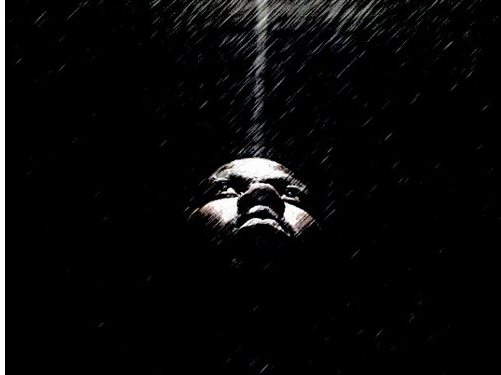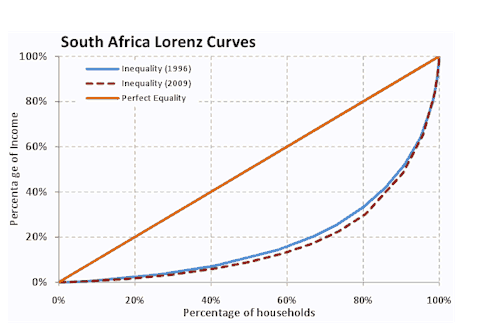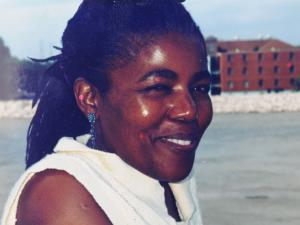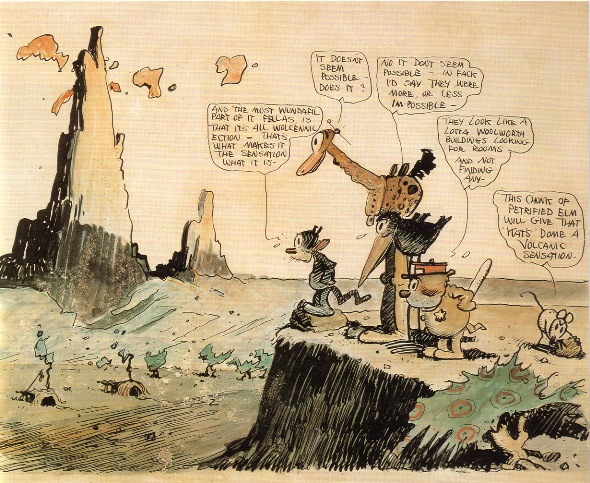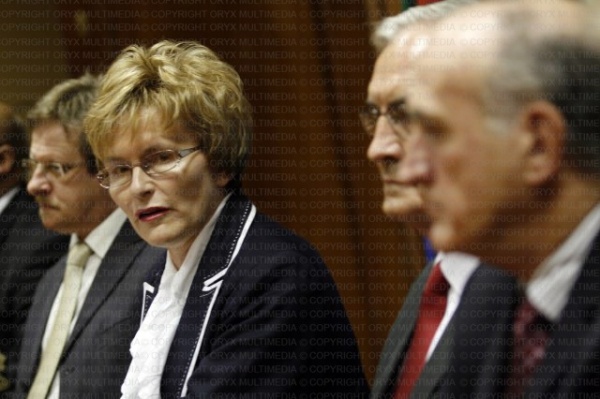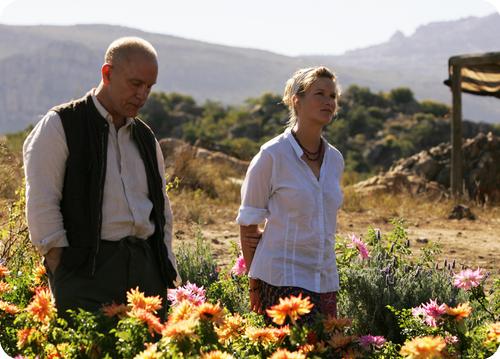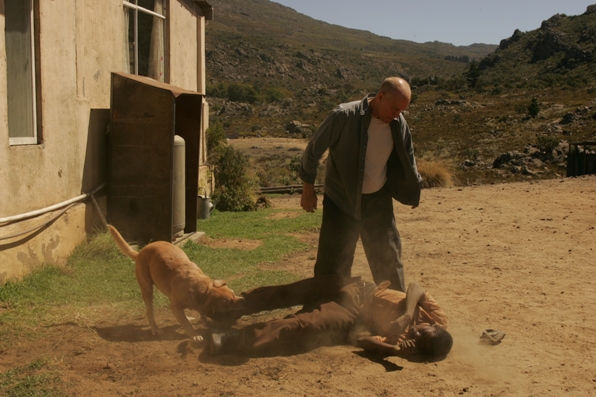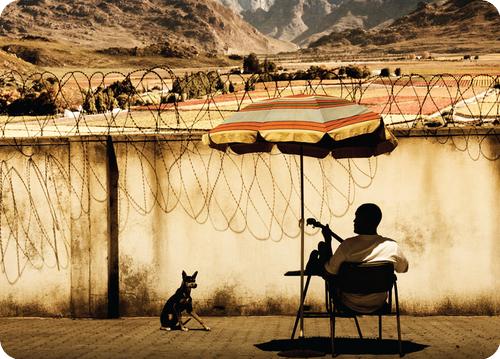Our Chernobyl
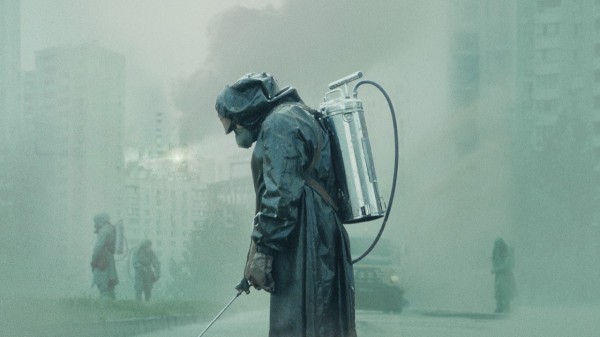
Craig Mazin’s Chernobyl — a brutal, beautiful, frightening piece of film making — tries to grasp in a net of images and story the worst nuclear disaster in human history, an accident that was in a sense the inaugural event of the Anthropocene: the first moment in which we humans suddenly experienced as an actual reality our own power potentially to render the world, the whole world, uninhabitable. The HBO series has two basic aims: first to convey the human reality of the story: the fear, pain and suffering experienced by those who went through it; second, to try to plumb its meaning; to figure out what the disaster was all about. It fails on both counts.
The first failure is admirable and forgivable. The series conveys with luminous clarity the texture of life before, during and after the disaster. But what the people suddenly caught up in the vortex of nuclear disaster actually went through is, in a real sense, not possible to convey. ‘The words are all wrong’, says Lyudmila Ignatenko, the wife of Vasily Ignatenko, one of the firemen who died in agony from radiation poisoning two weeks after rushing to the conflagration when Reactor 4 exploded in the small hours of 26 April 1983. Not the Lyudmila in the series, the real Lyudmila; the actual, historical woman whose account provides the inaugural story in Voices from Chernobyl, the social history on which the HBO version draws. She tells her story simply, even beautifully, but her words are of a reality that is unimaginable. ‘It’s all so very mine!’ she says of the experience of watching the man she was in love with basically liquify, day by day, on the hospital bed in front of her. ‘ It’s impossible to describe! It’s impossible even to write down! And even to get over.’ The worst and most painful parts, she says, she can’t even remember. It comes to her ‘in flashes, all broken up’: painful details, lodged in the body, toxic and ineradicable. A survivor of an experience whose most intense reality lies beyond words, even beyond memory.

Lyudmila
The second failure is the result of calculation, of smugness, of thinking you know the answers. Instead of conveying the full and terrible moral complexity of what happened, the series turns the story of Chernobyl into a comfortable and heartwarming narrative, into a parable about courageous, truth-seeking scientists confronting bureaucratic ignorance and Soviet stupidity. In a way, radioactivity becomes a baleful metaphor for truth itself: The nuclear reaction surging catastrophically out of control in the core, in response to the imperious arrogance of the buffoonish Anatoly Dyatlov; the chunks of toxic graphite littering the reactor site, nakedly contradicting the blind refusal of officials to believe that the core could explode; deadly isotopes sifting gently down from the sky or seeping up from the earth, while the government assures everyone they’ve got everything under control — all these become metaphors for the inevitability and the unstoppability of Truth, its refusal to be contained by bureaucratic obfuscation and propaganda. The gift of Chernobyl, Legasov admonishes his official superiors, is that it shows us that the truth does not care about our needs or wants. ‘It does not care about our governments, our ideologies, our religions. It will lie in wait for all time’.
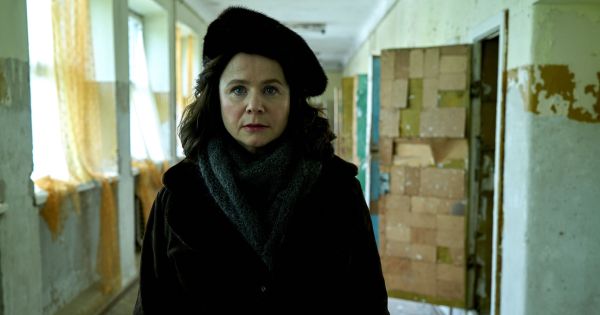
An imaginary scientist
There are three problems with this. The first is ironically enough, that it’s a lie. As Masha Gessen pointed out in her rather angry New Yorker essay the makers of Chernobyl can only get the story to carry its uplifting message by twisting real events out of shape: through making Valery Legasov a far less ambiguous, compromised figure than he really was; through the many ‘repetitive and ridiculous’ scenes in which heroic scientists confront truculent bureaucrats; through the totally invented, totally improbable figure of the doughty Ulyana Khomyuk, an imaginary scientist straight out of Hollywood fantasy; and above all through staging an entirely fictional, impossible trial where Legasov theatrically unveils, in spite of KGB efforts to keep it quiet, ‘the truth’ about the design flaws in the RMBK control rods that finally led to the meltdown.
But that’s not the truth, it turns out: though Gessen does not mention this, the series’ diagnosis of the ultimate causes of the disaster — that a paranoid Soviet government censored evidence about the dangers of those graphite-tipped control rods, keeping the information out of the hands of its own scientists — is a complete misrepresentation. The reality is rather more tawdry: the Soviet nuclear community knew about that design flaw, but just never acted upon it. They just didn’t think it would ever really be a problem.
Secondly, the implicit historical exceptionalism in the series — the repeated suggestion that the train of events leading to the accident and the attempts to cover it up is somehow specifically Soviet — does not hold water. The reality is much more unsettling. A glimpse of that picture is offered, for example, in Karen Brown’s account of Western collusion in the attempts to downplay the seriousness of Chernobyl’s aftermath. It is not only in the Soviet sphere, it turns out, that the warnings of scientists get ignored, or unsettling realities about the danger posed to our life on Earth by own industrial civilization are passed over and denied. (But you know that. Today, in 2019, you know that). And if truth be told, one thing the series does give an inkling of is the decisiveness of the Soviet response once it realised what it was dealing with. Would a society governed by market forces be willing or able to scrape 30 centimetres of topsoil off thousands of hectares of farmlands? Or send in more than half a million civilian and military personnel into a nuclear fall-out zone to evacuate an area and clean it up?
Here’s one clue: the contingency plan of the government of the Western Cape in South Africa, in case something bad happens at Koeberg, the ageing nuclear reactor built just about astride a geological fault a mere 50 kilometres north of my house, involves the evacuation of the local population by minibus taxis. That’ll work!
Are these liberties with the truth poetic license, an attempt to simplify the story so that it can be told more effectively? I don’t buy it. For the overall artistic consequence of this moralising spin is that it causes the story to drift away from its emotional centre. This is my third, and in a way my most serious objection. If dramatic licence was required to impart a sense of drama to an otherwise dry or overly complicated historical record, it would be understandable. But in this case, it does not really seem warranted. People battling frantically to contain a runaway nuclear reaction? Soldiers and miners risking their lives to avert disaster? Hundreds of thousands of lives shattered by sudden forced evacuation, or blighted by creeping illness? It’s not as if this is a story that needs to be spiced up or given artificial dramatic interest. And in fact, there is a gradual leaching away of energy as the story winds on and the initial wrenching scenes of disorientation and fear give way to the battle between apparatchiks and scientists, and the trial’s schoolroom lecture about how a nuclear reactor works.
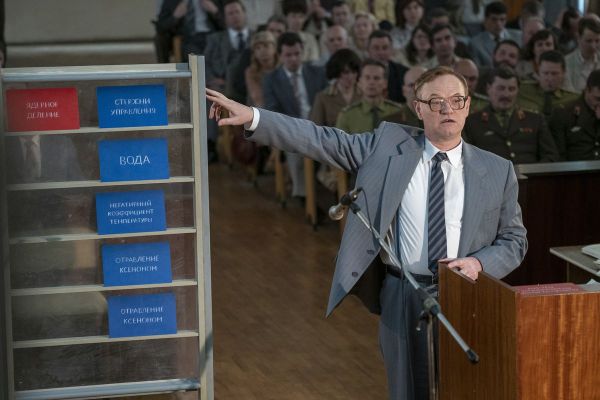
This, for me, is the real issue with Chernobyl. Because what’s really strange about it is how it allows some of the most emotionally compelling and unsettling aspects of the crisis to slip through between the lines. It is as if the meaning of what we see is right there in front of our eyes, but still remains unsayable. For the drama and the power of the story does not come from this staged confrontation between scientific truth and bureaucratic lies. It comes from the uncompromising and visceral way in which it conveys the sense of a world suddenly gone nightmarishly out of control. The central scenes in the series were for me dreamlike: instantly recognisable though I had never been there; refusing to be banished from memory even days after viewing. The panic and chaos in the control room. The fireman curled up in agony around his hand, burned by invisible rays from the graphite. The divers endlessly plodding through the claustrophobic dark in the waterlogged basement of the reaction, listening to the chattering scream of the dosimeter. The cleanup squads, blundering about in the rubble on the roof above the yawning maw of the reactor, racing against time. Lyudmila Ignatenko and her husband. People thrust into a world that has suddenly and incomprehensibly become an inferno; trying heroically and sometimes futilely to deal with dangers they do not completely understand; dangers that they cannot see; but a danger that they slowly realise they brought on themselves. Human technology — yes, human science! — revealed as a pandora’s box from which invisible horrors emanate, malign and unstoppable.

Think about it.
A world turned into inferno.
Dangers we cannot see, that we do not know how to control.
A world at risk of becoming uninhabitable because of our arrogance, our ignorance, our refusal to heed warnings. Our foolishness.
Warnings that were all around us.
The thing about climate change, and about the ways it will change our lives is this: we can’t blame the Soviets. And there won’t be a grimly decisive Boris Shcherbina to save us. We’ll be on our own.
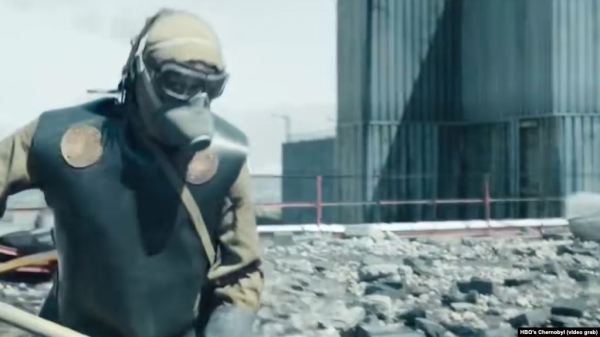
Outside Parliament

Picture: Poloho Selebano
I arrive at beginning of the #feesmustfall march on CPUT’s Cape Town campus a little before 12. I’ve Uber-ed here, deciding to leave my car in the Gardens Shopping Centre not far from where the march will end. A good decision, as traffic is already disrupted, with hippos and other police vehicles lining the street up and down the Keizergracht. It’s the hottest day of the spring so far, with a blazing hot sun and no wind. Perfect marching weather!
The march has been called by the Cape Peninsula Technicon, but it has swelled to include a number of different groups, including #feesmustfall students from UWC and workers campaigning for an end to outsourcing. The plan is to proceed to Parliament, where our embattled Minister of Finance is about to present his mid-term expenditure framework, and to present him with a memorandum of student’s concerns. After the fractious days of the last few weeks, and the fears of polarization on our own campus, this has seemed to me and many of my colleagues to be an important opportunity for trying to build bridges. If the struggle around student fees continues to be framed as an adversarial struggle between students on the one side and university management on the other, we’re all in trouble. The ability of this movement to lead to positive change depends, or so it seems to us, on our ability to construct a broader alliance of students, staff and University management around (among other things) the need for better funding for tertiary education.
I have been particularly concerned by a dangerous dynamic unfolding on campuses. Now, as during last year’s protests, a prominent role has been played by groups of angry young people indulging in reckless, even violent acts. Alongside open, inclusive, ‘intersectional’ approaches there have also been chauvinistic and coercive ones. How these different aspects of the students movement relate, and how they will work out, I don’t completely understand. But it seems to me that these tendencies are exacerbated when students feel alone and unsupported. If they feel less isolated – if they know that teachers and other staff on campus support their broad demand for more accessible, more relevant education, or are simply there in sympathy – this may prevent the destructive dynamic of increasing conflict. So this seems to be an important moment. At UWC, FMF students rather peremptorily instructed our University management to join them. University management (unfortunately, in my view) declined. And though that is a disappointment and (I think) a lost opportunity, I’ve decided to come in my own capacity and be part of this thing.
CPUT is alive with young folk – I am not good at estimating numbers, but it looks like upward of three thousand people, scattered on the grass and on the terraces behind the admin building. The event has that sense of organized chaos so typical of large, free-flow crowd events. Peace monitors are everywhere in evidence. There is also a visible presence of marshals. At the same time it’s a situation where it’s going to be very easy to lose track of any friend or colleague you want to meet. Calling people on phones is useless, as the noise levels are too high; and I’ve already met two people whose smartphones have simply shut down because of overheating. High-latitude technology. But soon enough I bump into some UWC colleagues. I’m told that as academics, we have been asked to ‘join the clergymen.’ This is not a thing I’d do instinctively – I’m more one of your rootless, secular cosmopolitans – but today my intention is to do what I can to help make this thing work. Eventually I find someone who looks like a clergyman (male, frock, white dog-collar, seems legit) and stick to him.
The mood is ebullient and festive. Someone with a loudspeaker in the centre of the crowd is briskly addressing us all, enjoining us all to be disciplined and to not harass other marchers. I am glad to hear this, given that there has been talk of disrupting the DASO march also taking place today. Very little in the way of overtly political signage, though EFF’s red and PASMA’s green is everywhere in evidence. Most signs are hand lettered and improvised. The biggest one I can see calls for ‘Free Education or Death,’ which frankly sounds like a bad idea. Someone else has a big crucifix. There is also a small cardboard coffin tossing like a little ship on the heads and shoulders of the crowd, bearing a picture of Education Minister Blade Nzimande.

Picture: Ashraf Hendricks, Groundup
Then we’re off. A little early, according to my watch, and surprisingly quickly. At the beginning it’s more a jog than a march, and pretty soon I’ve lost touch with my clergyman. No matter, since I have made contact with friends, students and colleagues, and also with my sister Marijke. She’s there with her own neatly printed sign saying ‘Siyavelana nabafundi bethu’ – we hear / feel our students. (Mine says, rather unimaginatively ‘Education for Liberation.’ ) A group of colleagues have transliterated Marijke’s slogan onto a long cloth banner and are endeavouring to walk in line carrying it at the front of the march. For a while I try to join them in this enterprise, but there is simply too much jostling and after a while I fall back from the frontline, moving with the crowd.
In all of this the festive, jovial, playful mood of the young people is evident. The crowd is diverse, composed mostly of CPUT students; all full of the joys of spring. There is much improvisatory playing with protest songs, greatly enjoyed even by those who do not (or, like me, are unable to) take part. None of my generations’s lugubrious Senzeni Na for this crowd; the songs are snappy, cheerful, brimming with energy. Early on in the march, we are suddenly pelted by light little pink packets. These seem to contain face masks. For teargas, someone explains. More pink packets shower us from a different direction. Condoms. (Apparently the lubricant provides relief against teargas. One lives and learns).
Police are monitoring us closely. Initially there are some attempts on the part of the police to get us to march in an orderly fashion with marshals in front but this proves futile. Fortunately, this does not spill over into violence: marchers, peacekeepers and police all seem to agree that the thing to do now is to get to Parliament as smoothly and pleasantly as possible. We move fairly chaotically but still smoothly and rapidly up Keizergracht, past the parade, and up Buitenkant.
Passersby and onlookers seem irritated (especially those who are sitting in cars, mired in a traffic jam while the students flow around and past them). Others seem to approve and wave or applaud students from balconies. A lean and wiry fellow with a big Afro leans out of a high window and makes a black power salute, which gets an appreciative response. Roadside vendors prudently shutter their stalls. What strikes me is the multitude of scripts already in play. For us in the march, this is a jovial performative occasion, a moment to be seen and to be heard; for those in the cars and in the shops, we are an irritation and possibly even a threat.
Surprisingly quickly, we arrive at Parliament. The van of the crowd collects at the Stalplein, by that bombastic statue of Louis Botha on his horse. The crowd is large and fills up all of the last street block of Roeland. I suppose now is the time to go seek out my clergyman, but it’s a hot hot day, the crowd is jam packed and we’re probably in for a long wait. I head over to the other side of the street, where St Mary’s Cathedral and its adjoining palm trees promise some shade.
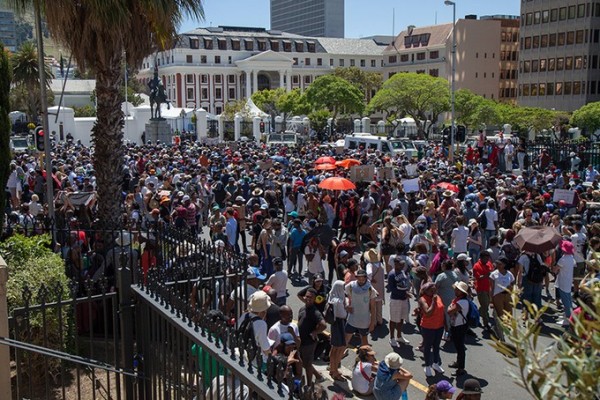
Photo: Ashraf Hendricks, Groundup
And there we wait. It’s not even 1 PM, (the march by which the march was supposed to start), so it’s a long wait. More a people arrive. The singing continues, with increasingly baroque variations. An enterprising couple of young white guys with the sporty, relaxed look of surfers walk back and forth between Roeland Street and the Stag’s head, carrying large plastic containers of water. The more forward-thinking people in the crowd bring out umbrellas to protect them from the sun. A helicopter appears and starts circling ominously, clattering by alarmingly close to the local high-rise buildings. Other than that, the mood is relaxed and calm. Those who are not singing get out their phones; start posing for selfies and checking their feeds.
I do the same: not for selfies, but for my WhatsApp thread and Twitter. Some journalist reports that Pravin Gordhan has indeed come out of parliament to meet with the marchers. Good man. Pravin is the man of the moment in South Africa, a solid little point of stability in a sea of venal bunglers. He seems to have made sympathetic remarks, telling the students he’s been in their position too. Later on, more tweets convey nuggets from his speech inside parliament; again, he takes a noticeably sympathetic stance. An encouraging sign, I think.
Time passes, and it’s not clear what happens now. Do we march back to CPUT? Or just wait for the 3PM curfew to roll around? What happens then? I connect up with two colleagues from PLAAS; we share office talk and thoughts about current events. People start drifting off. I am feeling tired and hungry. I get a message from my partner; my stepdaughter Ruby is sick and needs to be taken to a doctor. I say my goodbyes and leave Roeland Street.
Later in the day, I monitor things on Twitter and on our collegial WhatsApp thread. All seems well. Someone posts a lovely picture on Twitter of of a group of students sitting on a police nyala in the heat of the day, completely casual and at peace alongside the police. An image of a moment of harmony.
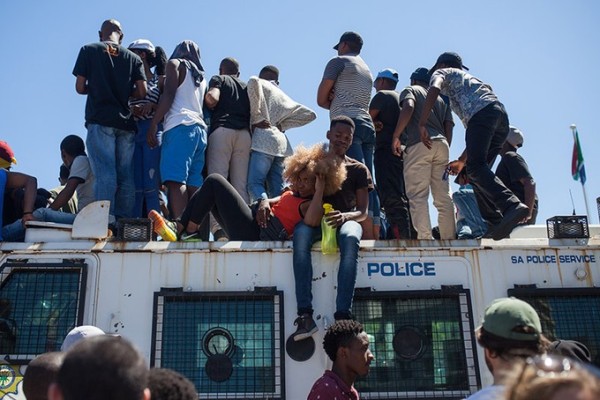
Picture: Ashraf Hendricks, Groundup
Meanwhile, Gordhan is making constructive gestures inside Parliament, promising R 17 billion more for tertiary education. Some journalists notice Zuma nodding off. Others report that Zuma’s cronies are looking bored and distracted, checking their phones. Maybe they’ve got other fish to fry, I think, than what happens in Parliament.
Then at 3 PM sharp, a colleague posts on WhatsApp. The fucking cops, she says, have just let rip with stun grenades and rubber bullets. What’s going on? “Fucking mayhem”, offers one colleague. “Fucking chaos”, says another. Someone reports “Rubber bullets down the side streets.” There was no warning, my colleagues say. The police just started shooting. There was no order to disperse.
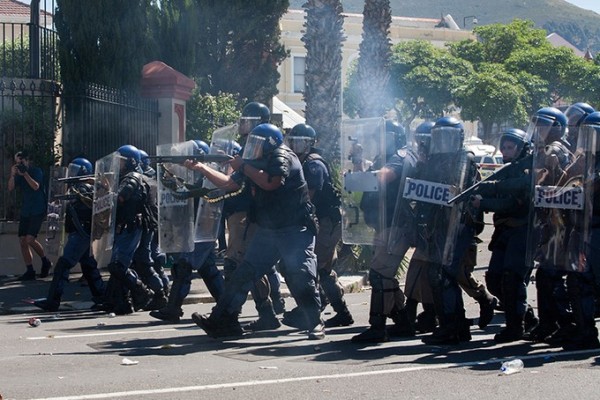
Picture: Ashraf Hendricks, Groundup
Oy vey. Audio clips get shared: scary snatches of gunfire sounds, screaming, angry shouting. Images of students running, throwing stones, of clouds of tear gas, of spent cartridges lying on the road. Stories also filter in on Twitter. Pictures of discarded shoes and broken or crushed sunglasses. What’s going on? eNCA reporters are posting clips on line, but they seem to be caught in a different reality, with a rattled Annika Larsen reporting the event as if the students had been the aggressors, and describing the march as ‘a standoff’ with students (why a standoff? They presented a memorandum and it was accepted by Pravin!). Other news organisations report that ‘parliament is under lockdown.’

Photo: Annika Larsen
From there things go the way they always go at such events: mayhem, injuries, running battles in the streets. Students threw stones at plate glass windows. Other students shouted at them to stop. A student got hit in the head by a brick thrown by another student. The violence spread down Buitenkant and onto the Parade. People stoned a bus and looted a Truworths store in Adderley street. Meanwhile, various eyewitness accounts by colleagues and strangers have the police moving up Roeland and its side streets, shooting indiscriminately at anything that moved.
Groundup estimates that the students involved in violence did not number more than 100.
I don’t have more valid insights into what happened here than anyone else who took part. I was far from the front lines, and I was not even there when the violence broke out. But I do have two observations:
First, it’s worth reflecting on how the violence started: One theory is that as the protest neared its rather anticlimactic end,and has students got rowdier and more restive, the coffin bearers decided to set fire to their coffin and throw it over the police line. This seems to have been the trigger that set everything off. You can see footage of this act online. To my eyes the coffin looks small and shabby; a little battered after its long passage up Roeland Street. A small knot of fire roils fiercely at its centre. There are angry shouts; things already look badly out of hand. The marchers surge forward and lunge towards the line of police officers standing behind their perspex shields. The coffin flies straight over the police line and falls harmlessly on the ground behind them. As a piece of protest theatre it is to my mind rather unimpressive. But as a moment around which the march could pivot into violence it is decisive. The police react instantly, letting off a barrage of rubber bullets and teargas, and within three seconds the whole street has slid into a chaos.
Later, posts do the round on Twitter, saying the cops had no choice, the students had thrown ‘a burning coffin’ at them; a depiction sounding far more dangerous and exciting than the prosaic reality.
Other accounts say that the police moved the Nyala with students on the roof and braked suddenly so that a student fell off; there are even allegations that the Nyala almost drove over the student who had fallen. On the video these actions appear either dangerously careless or quite deliberate. This may have been the event that triggered the coffin-throwing. As usually, there are a mass of sometimes corroborating, sometimes conflicting accounts. Fog of war.
Perhaps poor planning had something to do with it. As one colleague later remarked, in the old UDF days you would have made sure that there was also a leadership who could lead the march away from Parliament in time for the 3 PM curfew. Certainly many accounts of the last moments of the march indicate that groups of students were getting rowdy and defiant.
It is also clear that at this march, as on campuses all over the country, there were people – some students, some perhaps not – who did want some sort of violent confrontation. But during the time I was there they were far from setting the tone. On this particular day, it seems to have been the overreaction of the police that provided the tipping point and opened the doors to the script of violence. In my opinion any public order police worth their salt could have de-escalated the coffin-throw. A hand -sized fire extinguisher could have done the trick. With some fast and canny thinking, and co-operation with the leadership of the march, it should have been possible to end the day peacefully. But this did not happen. Instead, the police seem to have treated the coffin incident as the trigger that gave them permission to use force, and then used means of dispersal almost guaranteed to tip the day over the edge into violence.
Secondly, and in a way much more importantly, what strikes me most of all is what happened within a few short moments to the framing of the incident.
A day that initially developed as a certain kind of public democratic performance (a peaceful march, improvisation with protest songs, a meeting with a Minister, a speech in Parliament) was in a space of ten minutes transformed into a narrative of conflict, violence and securitisation. Students running amok. Stones heaved through plate glass windows. Passers-by assaulted. “Parliament under lockdown”.
The essentially good natured tone of most of the march, and the essentially serious and earnest response from the Finance Minister: these disappeared within moments, replaced by the aftertaste of teargas and burning rubbish in the streets; by anger at violent police and irresponsible students.
Who is served by this? It does not serve the students, or their cause. It does not serve the universities and technicons. It does not serve the Minister of Finance, and definitely not Parliament.
It serves those who co-conspire to create violence. It serves those for whom public disorder has its own rewards. It serves the chauvinistic agenda of groups like Black First Land First, whose members have in the past called for ‘fire’ to be brought to our Universities. It also serves those still defending white privilege, who prefer to see the students simply as thugs and hooligans. It serves the securocrats, and those (including those in our Cabinet) who believe that forceful repression is what is needed to make the problems go away.
It closes off, from the left and the right, the opportunities that still exist to create a meaningful and transformative politics on the basis of our students’ movement.
This is what is happening to our democracy.
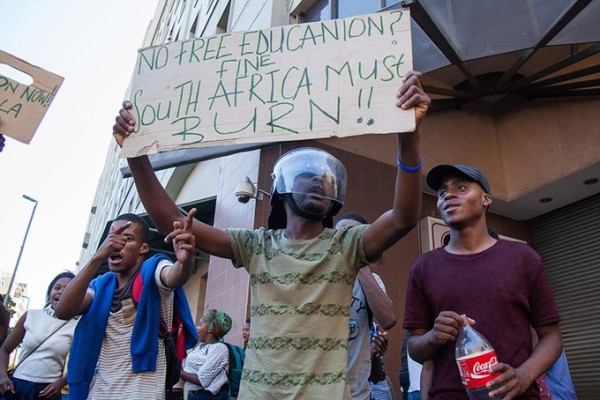
Photo: Ashraf Hendricks, Groundup
At the fitness club
This is just a note to say that the management of the club and I are in discussion. I am hopeful that we may be able to resolve matters.
For now I just want to say that my impression that VA did not take the events with sufficient seriousness may not have been entirely correct.
I now understand that a lot was going on behind the scenes that I was not aware of.
I have had a very long and detailed discussion with VA’s management, who have indicated that they were as horrified to read my account of what happened on 5 February as most of you have been and that they do take the matter very seriously indeed.
In particular, I must say I am satisfied that VA are quite sincere in their public statement that they have a zero tolerance attitude toward racism; not only in general but also in this case.
I may bring the original blog post back (quite aside from the matter of VA’s attitude, it still raises important questions about white rage and racial power in this country); but I also think that in all fairness I need to make sure that my representation of the club is fair and accurate.
I really appreciate all the support I have received and hope that it will be possible to use this blog to continue conversation about race, ‘listening’, power and change that we so desperately need.
imagine
The most thought-provoking words spoken at the Boksburg Inequality Conference that we and our partners hosted in Gauteng last month were uttered right at the end, almost as an aside, by the conference’s closing speaker, Neva Makgetla. Reminiscing about her days studying philosophy in East Germany (as it then was), she said that what had struck her was that that the original motivation of those who had tried to create a socialist society – the promise that they had struggled to fulfil – was that socialism would enable a change in the quality of human relationships. But in practice, trying to make a society work, they decided to focus on material things. Money, social services, schools. Perhaps here in South Africa, she said, something similar had happened. The struggle against Apartheid was linked to a dream of what could be possible in the new society, the possibility of something qualitatively different from the fear-filled disconnections constituted by Apartheid. But a country had to be run, programmes designed. And this is what we’re left with, she implied: BEE and social grants.
It was a sobering comment, for it made me think that perhaps we, the organizers of the conference, had somewhat lost sight of our topic. The conference had been organized in order to try to put the issue of inequality more squarely on the South African policy agenda. All too often, discussions about social issues in South Africa proceed as if poverty is a residual matter, the result of some people somehow being left out of economic growth: as if all that is required is to provide them with the assistance and opportunities that are needed to raise their incomes (the current reach-for-my-revolver term is to ‘graduate’ them) above some (usually unspecified) poverty line.
We wanted to challenge those assumptions. We wanted to argue that the central and most urgent issue facing South Africa is not poverty but inequality; and that in South Africa, poverty and inequality were structural. That our economy, while generating wealth for a few, is also a poverty machine, perpetuating and exacerbating steep and deeply rooted inequalities that threaten the basis of social stability and growth. We wanted to use the conference to cast a spotlight on this trend: to ask what kind of society was emerging, and to invite participants to explore what alternatives were possible. Could we imagine a different society, with different values? What would such a society look like?
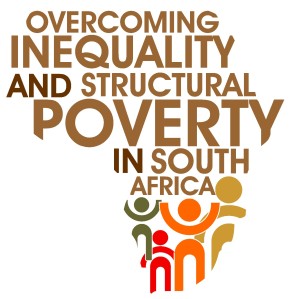 I was reminded of that aim on the first morning of the conference, when the organizing committee met in the Birchwood’s faux-Italian coffee shop to discuss the start of the proceedings. The conference would be opened by Deputy President Kgalema Mothlante (on DVD, the man himself being required at the ANC NGC in Durban) – after which there would be a recital by performance poet Flo. Flo was there, a shy, burly man with a ready smile. We chatted with him about his plans for his performance, and asked him what he thought he would recite. What would his poems be about? He thought for a moment and said, oh, social issues. And love. There was a moment’s embarrassed silence. Love? Well, I thought, perhaps that was precisely what we were here to talk about. All my relations, and the world they exist in.
I was reminded of that aim on the first morning of the conference, when the organizing committee met in the Birchwood’s faux-Italian coffee shop to discuss the start of the proceedings. The conference would be opened by Deputy President Kgalema Mothlante (on DVD, the man himself being required at the ANC NGC in Durban) – after which there would be a recital by performance poet Flo. Flo was there, a shy, burly man with a ready smile. We chatted with him about his plans for his performance, and asked him what he thought he would recite. What would his poems be about? He thought for a moment and said, oh, social issues. And love. There was a moment’s embarrassed silence. Love? Well, I thought, perhaps that was precisely what we were here to talk about. All my relations, and the world they exist in.
In the event, Flo’s poems were moving, thought provoking and disarming, and did their part to break the ice and get things moving. But pretty soon his words were forgotten, and the participants went ahead, doing what people do at poverty and inequality conferences: considering Lorentz curves, analysing political systems, discussing job creation and rural development. And at that level the conference was, as conferences go, successful. Makgetla’s presentation showed clearly how considering poverty on its own, in isolation, leads to narrow policies focussing merely on particular marginalized groups, while a focus on inequality leads to much more searching questions on the need for social transformation. Other presentations illuminated various aspects of the structural roots of inequality – the legacy of Apartheid, the failure to embark on an employment-intensive growth path, the continued dominance of capital- and energy intensive sectors, and the enormous levels of concentration and centralized corporate power in the formal economy. And there were searching discussions about particular policies and instruments – social protection, small farmer development, community work programmes – that could address these problems.
But in the end, listening to Makgetla’s closing words, I realized that we too, by concentrating mostly on the material, monetary aspects of inequality and poverty, had missed the opportunity to think about the nature and quality of social relations. Sure, there were some good analyses on gender and power relations in labour markets, and on the politics of pro-poor development. But most of our discussions had focussed on material resources, on institutions, on money and social goods. Granted, this was not a poetry conference. We were social scientists, government policymakers, development practitioners, community organizers; not philosophers or novelists. We talked about the things we knew. But what about the more elusive issues? What about thinking about the kind of society that was emerging at more moral, existential or ethical level? What about the obligations and bonds between citizens? What about identity? What about the cordoned heart? What about the structures of feeling, non-feeling and disconnection created by how power, money and fear move in this harsh land? In my own presentation at the conference, I had closed by asking what the scope was for a different project – not technical poverty management, or adversarial populist struggle, but on civic solidarity. Stirring words. But how does one even start thinking about how such a politics might look? Somehow, it is hard to thinking about this issue without getting lost in clichés and in potted thinking.
Hence this essay. My concern today is utopia; or rather, how to find a space for utopian thinking that can have grip or traction in this world. This blog is in the first place concerned with the myths we live by: the lenses through which we look; the resources at our disposal when we try to see what is found there, to imagine what it means, and to dream what’s possible. And in the case of thinking about ‘equality,’ about social relations, it’s hard to find a way of speaking that does not cause us immediately to get lost in prefabricated stories. Analyses of monetary inequality are all very well, but they are mistaken when they confuse the smooth curves that map the distribution of resources in society for social inequality which, as Charles Tilly has pointed out, is a thing of sharp distinctions, pregnant hierarchies, small differences with huge consequences: the difference between black and white, between master and slave, boss and employee. (Or to cite an example close to home for me, permanent university staff and talented researchers still on short-time contracts after 10 years of hard work.) The economists’ conception of perfect equality (everyone has the same income) is useful as a mathematical hypothesis, but it kind of misses the point. Utopian dreams of brother / sisterhood and inequality are deeply compelling (I still get choked up by that Lennon song…) but they’re closed, dislocated fantasies, shaped more by infantile longings for things not to be real than by a gritty assessment of what’s possible. And don’t talk to me about the South African variant: the way talk about racial relations shades so soon into sentimental fantasies about reconciliation, colour-blindness, impossible projects of reparation or essentialist lamentations about how terrible it is to be white. It can be fun for those who do it, but it does not offer much help for those who have to learn to get along, accomplish tasks, feed kids and run businesses in a world in which difference and antagonism are irreducible, real, and maybe even valuable.
So what can we imagine? What can and should we want? I don’t think I have answers. What I have is some disconnected dots; and my guess is that thinking about them may not give me a route, but at least it may help us get a sense of how the map looks, and the lie of the land.
So bear with my meandering argument here. A good place is to start with where we are. Specifically, the Rosmead shopping centre, in Rosmead Road, Kenilworth, where academic Gubela Mji, head of the Centre for Rehabilitation Studies in the Faculty of Health at the University of Stellenbosch Health, was brutally assaulted in September of this year. No-one knows what happened: Ms Mji was stabbed and had received blows to her head severe enough to leave her concussed, disoriented, and without a memory of the incident. A security guard had found her: he thought at first she was a homeless woman, barefoot and bloody, vomiting blood and asking for an ambulance. He sought help from what the newspaper article coyly calls ‘a national private health care chain’ with offices nearby. But in the eyes of staff there, Ms Mji, barefoot, dishevelled, incoherent and black, did not look like someone who could pay. They assumed she was a vagrant, and vagrants don’t get care. Only because the security guard who had found her persisted in his efforts did an ambulance service finally respond. The news story itself soon faded from view, with no follow-up after the first indignant headlines.
Consider what is at play here — both in the incident itself, and what makes it newsworthy. Firstly, the story shows how stark the divide is between the existence of those of us who belong within the institutional grid of power and wealth at the centre of our economy, and those of us who don’t; and how harsh the consequences are. It highlights the fragility even of privilege, and how easy it is to end up on the outside. Critically, it illustrates with depressing force the continued reality of race in this country (had Ms Mji been white, would she have been so easily consigned to the streets, with only a security guard to fend for her?). But the most shameful and perverse reality is this: the fact that this story is told at all only because Ms Mji is one of ‘us’, a member of the middle class; that we can identify with her and feel the fearful thrill of thinking, that could have been me. That’s why it’s a story. Homeless people are assaulted every day, and denied care. Everyday normality does not make the news.
This is the society we are creating, post-Apartheid. Not only are we one of the most income-unequal societies on the planet. Not only is this inequality increasing. Not only have we created a society bisected by deeply unequal relations of power and privilege, in which the marginalized have, in truth, no rights at all. Worst of all, we live here heedlessly, comfortably. Our hearts and imaginations have been numbed.
And you can see how this kind of setup perpetuates itself, how it feeds the desire to build the walls higher, and how it drives the hungry ghosts of self-enrichment and pointless, conspicuous consumption.
 So much for the obvious aspects of the story. Gubela Mji’s assault is in this respect like any story of shocking crime, a event which can function as an example to illustrate some troubling aspects of our society. But there is more to say.
So much for the obvious aspects of the story. Gubela Mji’s assault is in this respect like any story of shocking crime, a event which can function as an example to illustrate some troubling aspects of our society. But there is more to say.
For Ms Mji is not merely the subject of a story, a mute exemplar. She has a voice of her own. And by an irony rich and strange it turns out that in the past she has spoken eloquently and powerfully about these very issues. In a recent book about disability and social change, she is the author of a powerful and personal account on the exclusion and marginalization of the homeless disabled. Entitled with eerie precision ‘Disability and homelessness: a personal journey from the margins to the centre and back’ she recounts a journey of self-discovery that began when, as part of an investigation into the conditions of disabled homeless people, she lived for a week in a homeless people’s shelter. Here she had to confront her own feelings of discomfort at being in the presence of people who she had been accustomed to experience as ‘rude violent and drunk.’ Her subsequent reflections go right to the centre of the issue:
“…when I listened to someone’s life story, their problems, fantasies and struggles, something began to change. I was faced with the dilemma of wanting to hold on to something to distinguish ‘this kind of person’ from the kind of person I am. At the same time I found myself recognizing myself in their problems, fantasies and struggles…. I felt a deep concern at how far I had travelled from my rural childhood into the abstract violence of Cape Town’s urbanity, a social violence underpinning and underpinned by the abstract violence of my professional training and its attendant medical-scientific categorizations, codifications and pathologies. I was discovering in conversations with others a capacity that had been slowly eroded by the rationality and instrumentalism of my medical training and the bureaucracy and alienation of urban living”
This is the centre from which I think we can approach our question. For the power of Mji’s story is not only that by an awful irony she eventually experienced the enactment on her own body, on her own person, of the abstract institutional violence of an unequal society. It is also the precision with which she fingers her own personal complicity in that institutional violence. Wanting something to distinguish ‘this kind of person’ from the kind of person I am: Write that in letters of fire on the Union Building. Write that on every coin and Rand note in the country. This is how the divisions of an unequal society are mirrored and perpetuated in the very capacity to relate, to engage with others. And at the same time, Mji insists that there is something that can be undone; something that can be reversed. We can recover our ability to identify.
I find these reflections helpful when I consider the debates and dilemmas that shaped the conference. In my experience, I was particularly struck by what seemed to be a polarization or a disconnect between two very different ways of thinking about inequality and what could be done about it. Superficially, this disjuncture seemed to revolve around the hoary old sociological distinction between structure and agency. On the one hand, there were the researchers and analysts who emphasised the structural nature of inequality: the ways in which the domination of the economy by a highly concentrated, capital intensive corporate core undermined the basis for economic agency on the part of the poor. On the other hand there were the voluntarist accounts of community response and self-help: presentations that seemed to suggest that all that was required to resolve the problem was optimism and self-belief on the part of the poor, with a little bit of help from the State. Obviously both views had value, and spoke to part of the truth. But they seemed to exist in parallel universes, dead to the truth of each other’s arguments, and unable to see their own blind spots
Seeraj Mohammed’s presentation of labour market trends in South Africa was a very good example of the former. Mohammed’s account of the distorted development of the South African core economy, the continued domination by the minerals and energy complex, the failure of the middle class to invest in productive capacity, the centrality of credit fuelled spending and the disastrous impact of these trends on employment intensity was lucid and compelling. At the same time, what struck me most of all was the dispirited tone, and the disabling import, of this analysis. South African corporates and capitalists, Mohammed seemed to suggest, had acted selfishly to enrich themselves. Would one expect anything different? Apparently not. This was simply the way things worked in late modern capitalism. As an analysis oriented at action, it did not seem particularly helpful.
At the opposite end of the spectrum was a presentation by Lebo Ramafoko about Kwanda, a project initiated by Soul City, South Africa’s public interest messaging television programme. Charismatic and magnetic, exuding enthusiasm and confidence, Ms Ramafoko comes on like a South African version of Oprah, an impression strengthened by Soul City and Kwanda’s underlying message of emancipation through self belief and media attention. Poor local communities accessing funds for community works programmes are selected to participate in a national competition. Kwanda makes short documentaries about each community, showing their problems, highlighting the heroic efforts of local residents to address these issues; visits six months later, assessing the extent of progress made – and then invites viewers to share their advice and opinions, and to vote for their favourite projects.
It is, in other words, social development through reality television, and pretty well done television too. The clip shown at the conference portrayed, with the upbeat urgency and streetwise funky vibeyness that characterises youth television, the problems of a community called Peffertown, a peri-urban slum somewhere in the vicinity of Port Elizabeth. Dreadlocked bergies puffed at white piles, depressed community members recounted awful stories of random violence. The heroine of the story was a determined local girl called Denise, who worked to bring together community members to try to make things better. Stocky and uncompromising, with a handsome, clear-eyed gaze, she was a member of the local women’s rugby team, and she brought to her community engagement the same commitment and fierce passion she showed on the field. It was compelling viewing; a kind of strange hybrid of Andy Warhol and Che Guevara: everyone will be famous for fifteen minutes – but as a community activist.
But how realistic is all this? Lebo’s enthusiasm tempted one to believe that this is how inequality could be combated in South Africa – simply by using the connective capability of social media to create a virtual community founded on optimism and self-help. But virtual communities are evanescent, community works programmes are temporary measures that can only ameliorate the worst effects of neglect and under-investment. If the core economy fails to generate jobs, can Kwanda do more but create hype and excitement around what is, after all, band-aid?
Those are important questions. But at the same time, much would be lost if we simply dismissed Kwanda and the voices it gave space for. This is where Mji’s thoughts help us see something of value that we might miss. For Mji does not treat the loss of community feeling, the abstract violence of the withdrawal of social solidarity, as inevitable. She reminds us that capacity for it still exists. She links this capacity very much to her own cultural resources as an African woman from a rural area. But the capacity exists in us all. It is nothing more than psychological projection ; the ability and the willingness to recognise something of oneself in another.
Kwanda thus highlights two key points. Firstly, it gives an indication of how close to the surface our South African utopian imagination still lives; how real the underlying inclination of goodwill, fellow feeling and solidarity still is. And secondly, it has found a way of mobilizing this energy: it has used the power of television and media to allow parts of South Africa to have a kind of love affair with itself.
Love affairs are interesting things. The one we thought we saw is never there. Projection is, after all, illusory. But it’s a productive illusion. It can start a journey of fruitful disillusionment, a process of discovery and change. Much can be given and gained. For all its naivety and cheesy optimisim, in other words, Kwanda does something the leftist critique of structure often fails to do: it constructs a subject position from which action is still possible.
So despite its limits, Kwanda suggests the possibility of a different way of proceeding. In a way, it’s like the World Cup, where the dream of welcoming ‘the world’ allowed us to feel, for a few weeks, that the country where we would like to live really existed. Not Singapore, not Switzerland, not Sweden, but a warm hearted, vibey, ordinary country in the South. But the World Cup as an ideological project pivoted, really, on our deeply charged, troubled, relation with the North; our desire to be recognized and seen by something we call the World. It was, in other words narcissistic in the strict sense of the word; a desire to appear in a certain way in the eyes of an authoritative Other. The moment that Other disappeared, the moment we were no longer on the TV screens, the moment we could no longer see ourselves reflected in the distorting mirror of the World’s gaze, the warm glow disappearted.
My question is really about the space, in South Africa, for a discourse of civic solidarity. Can we define ourselves not in relation to the world’s gaze, not in relation to a feared interloper, but to each other? Can we find a way to meet ourselves, “at our own door, in our own mirror”? Can we act as if in some way — divided by antagonisms, to be sure, riven by hurts, burdened by memory — there is, in the end, an ‘us’? Can we imagine that?
leaving the world: avatar
‘If a man could pass thro’ Paradise in a Dream, and have a flower presented to him as a pledge that his Soul had really been there, and found that flower in his hand when he awoke — Aye, and what then?’
Samuel Taylor Coleridge
As my friend Liezel said, it’s not Woody Allen, is it? I know what she means. Not that Allen’s movies are particularly cool or cerebral these days anyway; and Emmerich knows there are plenty cruder, more clichéd films. But there are few movies on the commercial circuit that convey their clichés with such starry-eyed conviction, or where the stakes are quite as high. In a decade of CGI-dominated, predictable films, what sets Avatar apart — what makes it both worth fascinating and troubling—is the naïveté of its message, the lyricism with which it presents its utterly unconscious material, the starkness of its moral universe, and the manipulative and crude way it resolves its central contradictions. I’ve seen it twice now: each time I came prepared to see its flaws — the first time because of negative word of mouth; the second because, well, it was the second time — and each time I found myself swept along heedlessly, transported by the sheer lyricism of the moviemaking. And each time I felt flat and disappointed the next day, as if whatever had held me the night before had turned to dust.
The plot is simple: humanity is colonizing a jungle planet (actually a moon orbiting a gas giant) rather wonderfully named Pandora. The RDA corporation is strip-mining Pandora for a valuable mineral with the cringe-making name of Unobtainium. The chief obstacle in their way is not only the local environment (the atmosphere is poisonous; and the jungle is a dense, teeming Darwinian hell) but also the natives, a humanoid species called the Na’vi. They are physically formidable (they have carbon fibre in their bones, are about twelve foot tall and —the leathery Marine captain in charge of security tells us — they hard to kill); but more to the point, they are opposed to the human presence in their forest. A team of anthropologists have been trying to ‘civilize’ the Na’vi and to study them; as part of doing this (to build trust, I guess, and to avoid being killed) they don’t meet them physically: instead, they have their consciousnesses projected into vat-grown alien bodies – the Avatar of the title. The hero, Jake Sully, gets lost in the jungle in avatar form and accidentally ends up among a clan of the Na’vi called the Omaticaya. Instead of violent barbarians, he finds, they are sophisticated primitives; prelapsarian stone-agers living poetically in tune with their environment. Far from being a hell-hole, the forest is their paradise, and their spirituality is the worship of Eywa, a Gaia-like Mother Goddess embodied in a sacred tree. Forced to make a choice, Sully goes over to their side, and organizes the resistance that sends the colony – and humanity – packing.
 This is all familiar territory, of course. The plot is an old science fiction standard; large sections of it (particularly Miles Quaritch, the redneck ex-Marine security man) seem to have been lifted bodily from an old Ursula Le Guin novelette called The Word for World is Forest (Quaritch is the spitting image of Le Guin’s Captain Davidson, whom she calls the most one-dimensional character she ever created). And within the frame of this story, James Cameron and John Landau have decided to bludgeon us with every noble-savage, white-man-loved-the-Chieftain’s-daughter cliché and stereotype in the book. From the word go, you know how it is going to unfold. It’s going to be Pocahontas meets Platoon. It’s going to be The Mission meets Dances with Wolves. The natives are going to be noble savages; the chief is going to be dignified and wise; his wife will be a sangoma with dreads and second sight; there will be a jealous brave who wants to kill Jake in the beginning but who becomes his comrade in the end; the aliens will be willowy and high-cheekboned; they will spout Buddhist koans; they will be wisely in touch with nature and the spirit world … but most of all, it will be a white man – oops, sorry, a human being – who awakens the natives from their rapturous trance and rescues them from the evil corporation. And so it all in fact unfolds. Moreover, all of it happens without a trace of irony, cheesy dialogue and all.
This is all familiar territory, of course. The plot is an old science fiction standard; large sections of it (particularly Miles Quaritch, the redneck ex-Marine security man) seem to have been lifted bodily from an old Ursula Le Guin novelette called The Word for World is Forest (Quaritch is the spitting image of Le Guin’s Captain Davidson, whom she calls the most one-dimensional character she ever created). And within the frame of this story, James Cameron and John Landau have decided to bludgeon us with every noble-savage, white-man-loved-the-Chieftain’s-daughter cliché and stereotype in the book. From the word go, you know how it is going to unfold. It’s going to be Pocahontas meets Platoon. It’s going to be The Mission meets Dances with Wolves. The natives are going to be noble savages; the chief is going to be dignified and wise; his wife will be a sangoma with dreads and second sight; there will be a jealous brave who wants to kill Jake in the beginning but who becomes his comrade in the end; the aliens will be willowy and high-cheekboned; they will spout Buddhist koans; they will be wisely in touch with nature and the spirit world … but most of all, it will be a white man – oops, sorry, a human being – who awakens the natives from their rapturous trance and rescues them from the evil corporation. And so it all in fact unfolds. Moreover, all of it happens without a trace of irony, cheesy dialogue and all.
And yet, and yet. And yet the movie draws you in; and at times manages to move and enthrall. What is interesting about Avatar is the way in which it manages to bring off this predictable story, manages you to suck you into its world; not in spite of but because of the clichés.
One of the ways in which it does this is through its gorgeous visual texture. In one sense, the centre of the movie is not its story, nor its actors, but the visual technology of the film itself – the hallucinatory beauty achieved through the mixing of 3D digital film making, live action and computer animation. Cameron famously waited for more than a decade for motion-capture technology to become advanced enough for his project, and it seems in this respect at least he is completely vindicated. The sophisticated animation techniques give filmmakers an imaginative reach and power not seen in film before: if nothing else, science fiction and animated films will never be the same again after Avatar. More specifically, the film works because Cameron has succeeded in translating into movement (and into three dimensions) the visual and imaginary language of decades of psychedelic SF art. For me, that was a large part of the visual pleasure of the film. As a boy who loved science fiction, one of my greatest treasures was Brian Ash’s sumptuous Visual Encyclopedia of Science Fiction, which I got, I seem to remember, for my thirteenth birthday; a book that catalogued the way in which SF art progressed from those crude early twentieth century magazine covers (Frank R Paul’s garish covers for Amazing Stories, for instance) to the psychedelic and otherworldly images invented by the airbrush artists of the 1970s. I remember hours spent gazing raptly at the strange, evocative visions of those artists : Stephen Hickman, Michael Whelan, and, above all, Roger Dean.
This, by the way is one rather interesting aspect of the film: no-one who has encountered the art of Roger Dean (many will know him from those Yes album covers) could fail to experience a shock of recognition. Those strange, spindly, dragonfly-like spaceships; the unearthly sculpted landscape, the flying lizard creatures, the flying islands – all of these seem not just to be quotes from Roger Dean, but straight cribs. Yet Dean does not seem to get any recognition in the credits. As one fan site notes, when life imitates art, it’s one thing, but when art imitates art, it’s another.
But more is going on here than visual wizardry and artistic plagiarism. In a way, what the movie does visually is to split the world into two realms: the technological world of the Corporation, all steel and bulkheads, shot in grim, greyed-out colours, and the magical world of the jungle, which is presented as a fairyland. And I mean that literally. In a sense, the visual disjuncture in the movie marks (or perhaps hides) a genre disjuncture, for it seems to me that in emotional, genre and mythographic terms the jungle aspects of the movie are not science fiction at all, but fantasy. In entering the world of the jungle, Jake Sully enters the realm of Faerie – not another physical realm but another world entirely. This is particularly obvious in the sequences where Jake first arrives at Home Tree, the natives’ city-in-the-branches. Butterflies all round, glowing mushrooms, silver leaves, gargantuan trees with buttresses spiraling into the light: this is not Pandora, this is Lothlórien; and the aliens are not humanoids from another planet, they are Tolkien’s Elves, imbued with all the powers and qualities proper to them.
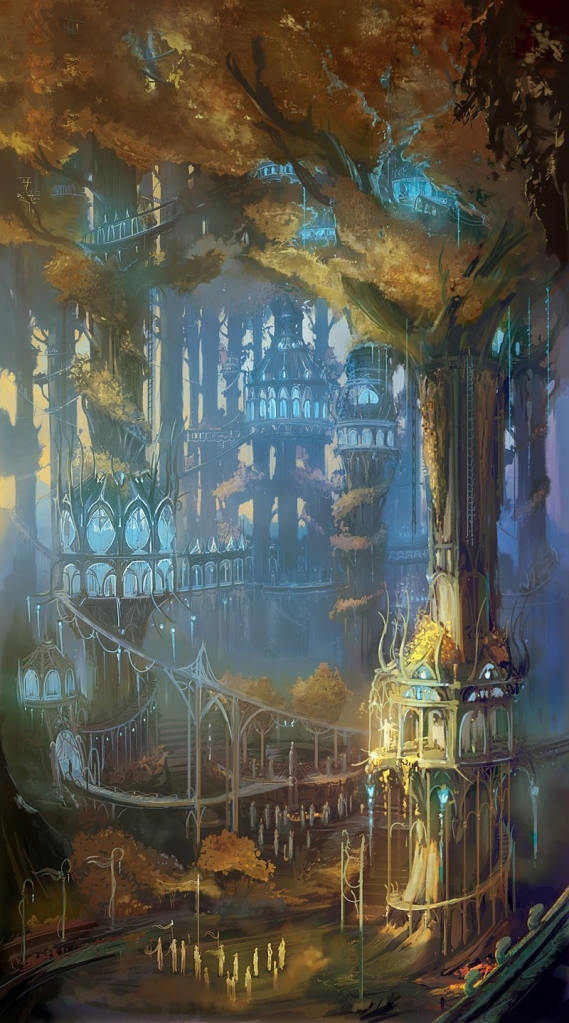
Lothlorien. Original image at http://www.lilithschilde.com/LOTR/lothlorien.jpg
Middle-Earth, of course, is an interesting place. It serves many ideological and psychological functions and holds many projections; but one of the most important achievements of Tolkien’s mythos is how it connected myth and archetype with, on the one hand, a distinctively late twentieth-century environmental imaginary (remember this about Gandalf: he was always the only wizard who really understood trees) and, on the other hand, a wistful, fey, elegiac romanticism. At the heart of this romanticism, I always think, is a longing for lost innocence, for youth departed; a yearning for the mythical memory of the time that magic was real, when we were one with the world, before we ate the fruit of the knowledge of good and evil.
This is the psychic and symbolic terrain occupied by Avatar; this is what gives it its emotional and psychological charge: its seduction lies in the starry-eyed conviction, the unblinking naïveté, with which it evokes the the possibility of Paradise, of being at one with the world, of living before the Fall. Nowhere is this fey, wild magic more passionately conveyed than in the long sequence where Jake Sully, as part of his rite of passage into Omaticaya manhood, has to capture, vanquish, “imprint” , and ride one of the flying lizards that live in the floating islands in the sky above the mother tree. Again, we are in solid science fiction cliché territory ( in this case, most obviously, the movie evokes Anne McAffrey’s Dragonriders of Pern books, a series of fantasy bodice-rippers where dragon-riders form a similar life-long bond with their mounts). But the sequence is ravishingly filmed. This is where the Roger Dean imagery really comes into its own. The camera gives us scene after unreal scene of unearthly beauty: the warriors swarming up a steep hill, snagging a passing root-tendril from a floating island, climbing up into the sky… each shot tops the previous one in eldritch weirdness and picturesque unreality. And the animation makes it all seem more real than real, bringing home on the screen the romance of the floating, flying world, the brutal, scaly weight of those lizard bodies, and the sheer thrill of flight. We understand, with a wrench, what this means for Sully, who in real life is wheelchair-bound: his rite of passage seems to have ripped him loose from reality altogether: an ex- Marine with a shattered body, locked in a metal pod connecting him to an artificial avatar, he is transported into this astonishing wonderland, scary and beautiful, in which anything can happen. And we the audience are taken along. Suddenly the plot is forgotten as we watch the lizard riders fly free through the sky; diving down sheer cliffs like so many BASE jumpers, lost in the exultation of flight. To my mind it is one of the most visually intense – and intensely lyrical – sequences cinema has given us in a long time.
But where to take all this? Just as the film’s effectiveness lies in its power to evoke the dream of life before the fall, it is in the context of its evocation of this dream that the film’s ultimate immaturity, and its betrayal of its narrative responsibilities, needs to be grasped. Having created this dichotomy – between the broken world of humanity and the whole one of the aliens, between industrial, technological life and the magical one – the film is posed with the challenge of figuring out how to resolve it. How indeed?
One way is the way charted by Tolkien, at least in the Lord of the Rings and The Hobbit. As you will remember, in both these stories we are continually being reminded that the time of magic is ending. The elves are leaving Middle-Earth; and though Frodo can go with them, sailing to the Western Shores, the last words in the book belong not to Frodo but to Sam. Sam does not get to remain in Fairyland; he has to return home to Rose and the Shire (a Shire which, though it has been spared Pandora-like mining and Industrial Revolution, is now increasingly part of the real world); here Sam will have to labour in his garden and take up adult responsibilities, his feet on the ground. ‘Well I am back,’ he says to Rose, turning his back on the Elvish world; and I have always thought it is a well-nigh perfect ending.
Philip Pullman makes the same point, in a different way, in the Dark Materials trilogy – not only in Will and Lyra’s courageous decision to close the door between the worlds, but also in Pullman’s intellectual debt to Kleists’s essay on the Marionette Theatre. In this essay, Kleist argues that the state of grace embodied in lost youthful innocence cannot and should not be regained. For Kleist, and for Pullman, there is no way back. We are thinking beings now, separate from the world. An angel with a burning sword guards the gate of Paradise. Re-attaining grace requires us to build the Republic of Heaven in this world: we have to go forward, use what we learned from the fruit of the Tree of Knowledge, forsake innocence, take up adult consciousness.
But the film does not follow this path. It could have done so: we can imagine a movie in which Jake leaves Pandora in its unspoilt wildness, taking the Corporation with him. Or the film could give us the real ending, the outcome we secretly know is inevitable: the World Tree killed, the aliens enslaved and alcoholic, Pandora terraformed, the jungle destroyed or preserved only in isolated natural parks. But this is not the story the film tells; it dares not tell it like this. No: somehow the garden of Eden must triumph… no, more; it must triumph and maintain its original innocence. That is what infantile desire (read: Hollywood convention) requires.
But the problem is that this cannot be achieved without breaking the unwritten rules of satisfying and true fiction. For a fictional victory to be psychologically true, for it to be resonant and satisfying, something must be lost. Frodo has to lose his living connection to Middle-Earth; Will has to lose Lyra; Ged has to give up his power. If nothing is lost, the prize offered by the story will be a hollow clanging shell. And so the movie descends into bathos: a pitched, armed confrontation between the Omaticaya and the forces of the Corporation. With this, despite all the visual wizardry, the movie loses its magic. We are back watching some kind of post-Nam jungle firefight. The point is not only that the Hollywood plot mechanics here are grimly familiar and utterly predictable, right down to that last physical battle between Sully, Neytiri and Quaritch (how many Hollywood movies right now are ending with one key figure fighting a desperate battle in a disintegrating exoskeleton? I count Iron Man, I count District 9, I count Avatar… ) It is that, try as we might, we cannot ignore the uncomfortable fact that Sully prevails only by turning the Na’vi into that which they oppose. One horrible jarring note is struck when we realize that somehow (it is never explained how) the Omaticaya appear to have acquired a lot of modern day electronic battle-comms gear, whispering tersely to one another over earbud headphones and microphones. Another is when the wild beasts of the jungle rise up together against mechanized invasion. This was not supposed to happen: As Neytiri explained earlier, Pandora’s mother-goddess looks after the balance of life and death itself; praying to her for help in an actual battle meant to go one way or the other is to misunderstand what she is about. The creatures of the wild are not supposed to be recruitable for tactical military maneuvres. But this is a Hollywood movie. Paradise may be Paradise, and the Balance of Life and Death is all very well, but if Nature really knew what was good for her, she would be revealed to be at heart American, viz. able to use organized aggression in the defense of Freedom.
And so it goes. The movie supposedly ends in triumph, but there is something anticlimactic about it, with the Earthlings sent packing like so many British colonialists after a particularly successful Boston Tea Party. It all feels contrived and dishonest. And the heart of the dishonesty lies in the film’s refusal to contemplate the possibility of waking up, of coming back from Faerieland.
Waking up, of course, is a difficult challenge. As Jungian analyst Julian Davis often liked to remark (apropos, I think, of the myth of Orpheus), it is easy to enter the Underworld; the hard thing is to bring back into the real world the treasures and the wisdom you found there. As I have argued elsewhere, Chihiro manages it in Spirited Away, going back into teenage life with her unsatisfactory parents, but having established her own connection with the River Spirit. The eponymous heroine in Coraline does not: she abandons the magical world, closing the trapdoor on the possibilities of yearning and desire. Jake Scully, in contrast, follows the path of Ofelia in Pan’s Labyrinth: Ofelia, you remember, chooses not to go back to the real adult world, opting instead to live in Faerie forever. Similarly the real climax, the final punchline of the movie is not the political resolution of the humans leaving Pandora: it is the last shot, in which Jake’s Avatar’s eyes open, signifying that he has died in his human body, and can live transferred to this artificial one, in this fantasyland, forever.
What is this saying about the culture that made it? Two things stand out. Firstly, and most obviously, like Dances with Wolves and The Mission, the film’s psychological immaturity reflects and enables an underlying political dishonesty. It enables an American, first world audience both to have its cake and eat it. On the surface the film seems to critique present day American imperialism (the head of the mining operation, Parker Selfridge, is a smug, golf-playing, chubby Bush lookalike, and the beefy Quaritch at times appears to spout verbatim Bushisms) but it never undermines the underlying dichotomies and splits that emanate from the colonialist, imperialist viewpoint. The most obvious and juvenile manifestation of it is Scully’s role as rescuer, and the movies cheesiest, falsest note — worse even than that Unobtainium, worse than the battle radio — is the moment when Scully leads the Na’vi in the preparations for battle. ‘This is our land!’ he cries; and the appalling dishonesty of that moment is the dark mirror of the breathless yearning of the dragon flight sequence. Less obvious, but as insidious, is the movie’s shameless exploitation of the noble-savage myth. A lot of what is queasy-making about Avatar is what is queasy-making about a certain kind of alternative modern consciousness in the real world: I am speaking here of the creepy ‘new age’ ideology that deals with an awareness of the unsustainability and violence of modern, industrial life by making ‘primitive people’ and ‘first nations’ the screens on which all our own spiritual and political needs are projected. Queasy-making because of the detachment from real life this split requires and enables: its refusal to acknowledge the reality of our existence in this broken, post-industrial world and its failure to recognise the physical and political reality of the ‘others’ upon which these golden fantasies are projected. (This is what made District 9 so fascinating: in all its evocation of xenophobia and racism, it is a much more honest attempt to imagine the encounter with the alien ‘Other’).

The first Avatar: Hiro Protagonist, in Snow Crash. Image by nClaire, posted here: http://nclaire.deviantart.com/art/Snow-Crash-Hiro-Protagonist-132297300
The second thing is this: linked to this detachment is the way the film evokes the power and centrality of notions of virtuality in modern imaginative life. The film’s title and central device is crucial here. Jake Scully’s avatar, at least, is flesh and blood (and, presumably, carbon-fibre strengthened bone), and is, we are told, worth millions. But in the real America, avatars are a dime a dozen. These days, ‘avatar’ does not stand for a divine manifestation; instead it is a word for a few lines of code, a pictogram with which you can denote yourself – and thereby assume a whole new persona — when interacting with others on the Internet. This usage of the word originally comes from Neal Stephenson’s novel Snow Crash, where people use avatars to inhabit an imaginary virtual universe called the Metaverse. Ten years after Stephenson’s novel, the Metaverse has attained actuality, for example in constructs like Linden’s Second Life, where you (or you avatar) can transport your whole social life into a virtual world, interacting with others, having (virtual) sex, and (crucially) buying property. It all sounds rather awful and boring; but at least it is not real. Reality… reality we don’t want. Not in our dreams.
And this is what Avatar seems to promise, with its gorgeous visual textures, its sumptuous three-D, its notion of projecting your consciousness into another body, another world. It seems to be a metaphor for the experience of cinema itself, for what it can promise. The tagline for the movie is evocative, double edged. Enter the World, it says. But what it really means is, Leave it. The real world is too broken. Industrial civilization may be raping the planet, but dealing concretely and practically with our accountability for our impact in the real world is asking too much from us. Let us rather sleep. Let us depart into the virtual, disembodied world. Let us dream.
Walking out the Cinema Nouveau after seeing Steven Soderbergh’s new movie The Informant!, which tells the true- life story of Mark Whitacre and his role in the investigation into price fixing at ADM, I was suddenly aware of a crawling, itching sensation of dread. All at once, fearful thoughts about the past week at work came crowding in — struggles with financial reports to donors, attempts to develop new funding proposals, my own career plans and decisions — and it all seemed too much: doomed to fail, puny struggles in the uncaring eyes of the Powers that Be. In the car on the way home, my father — usually not someone given to complaint — started telling me about his hassles with his pension company. The date stamp on his ‘life certificate’, which he has to send them every year to keep the payments coming, had been wrong, and for weeks now he had been on the phone to faceless voices at the call centre, trying to convince the company he was still alive. I found it an unsettling story, an unwelcome reminder of how powerless we really are — we, the supposedly valued consumers at the centre of our present-day culture of money and consumption — when we lose our foothold in the distributed systems of process and information that undergird our lives.
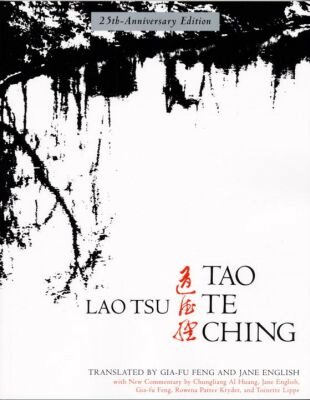 It reminded me of a few lines from Lao Tsu which have been pinging around in my head for some time now. We don’t know who ‘Lao Tsu’ was. The name (Laozi, in the new orthography) apparently means simply ‘the old master’; ‘he’ may in any case not have been just one person: there might have been a whole line of old men (and women, I am sure). But the poems collected in the Tao te Ching, obscure and evocative, often seem uncannily resonant of lessons to be learned today. When the Way is lost, it says in Chapter 38, there is always goodness. When goodness is lost, there is love or kindness. When kindness is lost, there’s justice. And when justice is lost … well, then you’ve got HR and Customer Relations Management. Well, that’s not the way he put it – the text says ritual – but you get my drift: we’re in trouble. In my current job as manager in a small university-based research unit, I have been much concerned with thinking about the systems and processes that can make working life either rewarding, empowering, enjoyable, or a living hell. (And those worlds, let me tell you, can be a hair’s breadth apart.) Systems are important, all right, and so are procedures, and so are policies aimed at addressing gender discrimination, or racialized exclusion, or unfairness. But the more I do this work, the more I am convinced that it is the integrity of our relationships with one another and ourselves, the quality of attention that we can bring into the workplace that really makes the difference. I am not sure whether a policy research organization operating in today’s divided, disconnected world can ever manifest the Way that ‘Lao Tse spoke about. Even “Goodness” (real virtue, which does not seek to be recognised as such) seems improbable. But Kindness seems to me to be a minimum requirement, and you’d be surprised how hard that is. Well, not really. You are also a subject of present-day neoliberal capitalist bureaucracy — who isn’t? — so unless you are delusional, you’ve felt it too: that the rules and systems that regulate our lives in the present day world are not only impersonal and unfeeling, but dangerous too, and that underneath their rationality there is something deeply disconnected. Ritual and empty form, they rule our lives, and so, indeed we’re truly lost.
It reminded me of a few lines from Lao Tsu which have been pinging around in my head for some time now. We don’t know who ‘Lao Tsu’ was. The name (Laozi, in the new orthography) apparently means simply ‘the old master’; ‘he’ may in any case not have been just one person: there might have been a whole line of old men (and women, I am sure). But the poems collected in the Tao te Ching, obscure and evocative, often seem uncannily resonant of lessons to be learned today. When the Way is lost, it says in Chapter 38, there is always goodness. When goodness is lost, there is love or kindness. When kindness is lost, there’s justice. And when justice is lost … well, then you’ve got HR and Customer Relations Management. Well, that’s not the way he put it – the text says ritual – but you get my drift: we’re in trouble. In my current job as manager in a small university-based research unit, I have been much concerned with thinking about the systems and processes that can make working life either rewarding, empowering, enjoyable, or a living hell. (And those worlds, let me tell you, can be a hair’s breadth apart.) Systems are important, all right, and so are procedures, and so are policies aimed at addressing gender discrimination, or racialized exclusion, or unfairness. But the more I do this work, the more I am convinced that it is the integrity of our relationships with one another and ourselves, the quality of attention that we can bring into the workplace that really makes the difference. I am not sure whether a policy research organization operating in today’s divided, disconnected world can ever manifest the Way that ‘Lao Tse spoke about. Even “Goodness” (real virtue, which does not seek to be recognised as such) seems improbable. But Kindness seems to me to be a minimum requirement, and you’d be surprised how hard that is. Well, not really. You are also a subject of present-day neoliberal capitalist bureaucracy — who isn’t? — so unless you are delusional, you’ve felt it too: that the rules and systems that regulate our lives in the present day world are not only impersonal and unfeeling, but dangerous too, and that underneath their rationality there is something deeply disconnected. Ritual and empty form, they rule our lives, and so, indeed we’re truly lost.
Which is what this film captures so beautifully. When I first thought about the bare bones of this story – a whistle-blower alerts the FBI about price-fixing in his company, but is then revealed to be involved in blatant fraud on his own account, and loses both himself and his FBI handlers in an ever-deepening tangle of lies and delusion — I wondered, what would the point of such a story be? It is indeed a strange and baffling tale, and Soderbergh’s movie accentuates its bizarreness. The cast lurch about from frame to frame in expensive suits, like so many earnest penguins, accompanied by chirpy instrumental jazz; changes of scene are announced in absurd purple day-glo 70s lettering: you cannot take this seriously. And the action’s just surreal: the seriousness of the characters themselves is continually undermined by the ludicrousness of what is happening, as the plot itself descends deeper and deeper into unreason. Over and over again, the movie repeats what is in essence the same gag: Whitacre, who’s until now assured his handlers that this time he’s really been telling them the whole truth, calmly and without warning reveals a whole new layer of larceny and lies, laying them on the table with naive confidence, like a deluded poker player triumphantly displaying a losing hand. 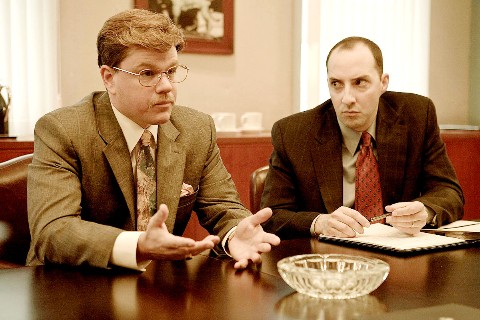 And what we laugh at is the silent consternation evident in the carefully blank face of his handler, or his lawyer, as he watches his client self-destruct and leave them in the lurch. This is what the prosecution in the Selebi case must be feeling right now, as their star witness calmly destroys his own testimony. The film plays it for laughs: they sit slack jawed and goggle eyed, immobilised by horror as they watch their case fall apart before them. It’s funny, but it’s also not funny: though we laugh, it is with an undertone of discomfort. And no wonder. It’s a scary thing, getting lost in the layered realities of a pathological liar.
And what we laugh at is the silent consternation evident in the carefully blank face of his handler, or his lawyer, as he watches his client self-destruct and leave them in the lurch. This is what the prosecution in the Selebi case must be feeling right now, as their star witness calmly destroys his own testimony. The film plays it for laughs: they sit slack jawed and goggle eyed, immobilised by horror as they watch their case fall apart before them. It’s funny, but it’s also not funny: though we laugh, it is with an undertone of discomfort. And no wonder. It’s a scary thing, getting lost in the layered realities of a pathological liar.
‘What was Mark Whitacre thinking?’ That’s how the movie’s official website frames it, and it’s a good question. Initially presenting as the unlikely hero in a story of white collar crime — a slightly geeky guy motivated by the wish to be the hero’ — he is slowly revealed to be a lunatic, a fabulist: all that is solid melts into air; you do not know what or whom to you believe; and you’re left wondering, with horrified fascination, what could be driving such spectacular self-destruction. Most accounts of the film explain it by referencing the facts of the actual story on which the movie is based. Whitacre was suffering from bipolar mood disorder, they say; and in any case, being an undercover snitch for the FBI would drive most people bats. And don’t you think that it is unjust that he got imprisoned for so long for stealing a paltry nine million dollars when AMD stole hundreds of millions?
Well, personally, I don’t think it that is a very satisfying explanation. For one thing, the real-world veracity of a story is actually one of its less interesting aspects when you consider it as a story. What matters in a story is how it is told, how the events cohere. That a particular thing actually happened is in a way neither here nor there; the question is what does it mean, what role does it play? And in this regard, when you look at what is actually shown on screen, the real-life explanation clearly does not hold. I am no clinician, but what we see on the screen is not a bipolar individual. Bipolar people may be grandiose, but they don’t act like this. This is something far more disconcerting and edgy. Whitacre’s steady stream of lies, his apparent lack of morals or shame, his utter disconnection from people around him, and, above all, his ceaseless projection of a confident, sincere exterior, in the teeth of all the facts and all shared realities: these are symptoms not of a mood disorder, but of a much more severe disturbance. I may be mistaken here, but I say unto you: DSM IV. Axis II. Cluster B. Check it out, and be afraid. And be very glad if you have not encountered this in your personal or working life. I am talking psychopathic, narcissistic, or borderline tendencies at the very least.
This is where I think the casting of Matt Damon is particularly brilliant. Matt Damon comes to us from the Bourne trilogy, the story par excellence of the Man Without a Self — the man who does not know who he is, and whose only means of survival is continuous, improvisatory dissembling. But while in the Bourne movies we are invited to identify with the hero — those films are structured so that we continually share his confusion and his burning, single-pointed desire to survive — The Informant! puts you in the shoes of those who have to deal with the mounting chaos of all the ever deepening pile of lies. If you have been around it, you will know how disorienting, how scary it is to encounter this kind of personality disorder, and how much chaos and confusion can be sown. The thing is not only that you are dealing with a disturbed or damaged person; it is that their essential malfunction is often disguised by ahigh degree of apparent competence, a persona of considerable force and conviction. But this mask is all there is. When it slips, you will find, not an ordinary vulnerable human being, but another mask, another cover story, an another impenetrable surface, presented with unflappable conviction. And it’s scary, because the trick is that we very soon start feeling we are the crazy ones: we find ourselves in a dizzying mirror-world where the ordinary rules of human behaviour and compassion simply do not apply.
In other words, it’s corporate culture. This, I think, is the real point of this film. For the most noticeable aspect of the film, other than the frightening comedy of Whitacre’s ever more surreal lies, is its relentless evocation of the banal surface of corporate life. Every frame is a picture of Guys in Suits, of bland hotel interiors, of boardrooms and golf courses. Every image is of a world which asks you to conform while never giving you any safety; a world in which there is no access to anything natural, spontaneous, unconditioned or real; a world in which your future depends on your fooling the system into thinking you are what you think it needs you to be. In one of the most evocative moments of the film, the soundtrack plays a long Aspergerish monoloue by Whitacre, a story in which one company executive notices another’s tie is the mirror image of his own, and then falls down dead. The visuals show us a long, still shot of one of the FBI operatives — a representative of one paranoid, conformist, conspiratorial organization sent to spy on representatives of another — crouching over a box of cornflakes, contemplating it like Rodin’s thinker: a shackled man, clutching a box of artificial food. The image captures an important aspect of the film: though this is a study of corporate power, no-one appears powerful. The men wear suits, but they are stripped of dignity; hunched; their bodies tense. Everyone in the film — cops, executives, secret agents, judges — leads a life subject entirely to impersonal, bureaucratic organisations; but even conformity cannot guarantee survival, for to depend on them is to depend on something entirely arbitrary, unreasoning, untrustworthy, baleful.
So how else to deal with such an irrational, baleful reality except by turning lying into a way of life? Marc Whitacre’s most poignant characteristic is his deluded desire to be the good guy, the guy in the white hat. Well who doesn’t want to be that? But the co-ordinates he has chosen, the values by which he lives, are those of corporate America. And the point about corporations is not so much that they are soulless or impersonal. We should be so lucky. Think about it: endlessly grandiose; obsessed with appearances; lacking any sense of interiority; no capacity for vulnerability; bereft of compassion; virtuous only when trying to conform with the auditable, measurable indicators of virtue; and with only the most tenuous relationship to truth. If companies were people, they’d be psychopaths. These are the masters we have created. No wonder sociopaths do so well in business. There’s a deadly synergy between such folks and the culture they inhabit. And this synergy is the secret of both Whitacre’s initial success and his eventual failure.
But failure kind of saves him. Most of us learn sooner or later that heroes exist only in stories; that we have to be learm to be the flawed, ordinary people we really are. Marc Whitacre’s tragedy is that for most of the film he is unable to make this shift: he can only try, over and over, with increasingly ornate fabulations, to be the hero he thinks he needs to be. By the end of the film it is unbearable to watch: we watch him soldier on, unstoppably, caught like a fish on his own hook of lies. Only one person is able to release him. His wife, who all along has been playing along with him, maddeningly supporting him in his insanity, softly says to him during one of his meetings, Darling, you have to stop this. It is a terrible, delicate moment. It is the only time love speaks in the film. I’m not sure whether it is goodness. But it is kindness. She dares, oh so gently, to speak the truth; and at last he can be liberated from his cage of lies.
To be like us: Vulnerable. Slightly pathetic. Slightly lost: and therefore not so lost.
growing UP
UP is a typical Disney product: which is to say that it is goofily funny and thoroughly, unashamedly sentimental. It is also a Pixar product, which means it is it is witty, clever and technically sophisticated. Above all, it is an American movie, so you know right from the start that you are in for an upbeat, moralising experience. More specifically, you know that the movie will deliver a message, and that the message will most likely be the time-honoured hold-on-to-your-dream, be-true-to-your-family, you-can-always-be-a-kid romanticism that has made Hollywood such an effective purveyor of opiate for the masses.
Except that it is not. What struck me about UP was that, though it is funny, upbeat and sentimental, it is in the end also a very sad film. Though its visual effects and artistry are ‘magical,’ gorgeously picturesque and charming, its main concern is not with ‘living your dream’ but with relinquishing it; not with holding on to youth but letting it go.
 As in the case of some of the other movies I have reviewed on this blog, much of its impact pivots on the way in which it uses the visual language of animation to create its imaginary world. In a way, I suppose, the film that UP most clearly references in this respect is The Wizard of Oz: like Oz, the crucial dichotomy in the movie is between its beginning in the quotidian real world, grey and grim, and the way the plot is suddenly relocated — literally by way of a leap into the sky — into a technicolour dreamworld. In this particular case, much of the charm of the film lies in the kooky, zany world the art of the animation allows us to enter. There’s a lot of absolutely standard Disneyesque fare – the broad comedy of Charles Muntz’s pack of dogs, for instance. But the film goes well beyond that, and takes us on a truly surreal flight of fancy. One moment we are watching Carl Frederickson ease grimly, resignedly into his day on a wonky Stairlift; a few minutes we are seeing a grumpy old man trudge through the jungle, towing behind him a fat Asian-American boy, a motor-mouthed dog… and a house, suspended in the sky by a multicoloured cloud of helium balloons. The loopiness becomes truly florid when the boy and the dog befriend a huge iridescent tropical bird – a kind of outsize Seuss-look cross between an ostrich and a dodo, which falls in love with the boy Russel, attempts to swallow Carl’s walking cane, and is given to huge, wailing, passionate cries for no discernable reason. We have left behind not only ordinary reality but also the cutesy world of Disneyland. What is being referenced here is not Jungle book or Oz, but the rather more fey, surreal, cartoonish fantasyland of Krazy Kat. Krazy Kat is the moment at which American cartoons left popular culture behind and turned into something far more philosophical-poetical; and the surreal visuals of UP works in a similar way to signal that we are now in much more complex metaphorical territory.
As in the case of some of the other movies I have reviewed on this blog, much of its impact pivots on the way in which it uses the visual language of animation to create its imaginary world. In a way, I suppose, the film that UP most clearly references in this respect is The Wizard of Oz: like Oz, the crucial dichotomy in the movie is between its beginning in the quotidian real world, grey and grim, and the way the plot is suddenly relocated — literally by way of a leap into the sky — into a technicolour dreamworld. In this particular case, much of the charm of the film lies in the kooky, zany world the art of the animation allows us to enter. There’s a lot of absolutely standard Disneyesque fare – the broad comedy of Charles Muntz’s pack of dogs, for instance. But the film goes well beyond that, and takes us on a truly surreal flight of fancy. One moment we are watching Carl Frederickson ease grimly, resignedly into his day on a wonky Stairlift; a few minutes we are seeing a grumpy old man trudge through the jungle, towing behind him a fat Asian-American boy, a motor-mouthed dog… and a house, suspended in the sky by a multicoloured cloud of helium balloons. The loopiness becomes truly florid when the boy and the dog befriend a huge iridescent tropical bird – a kind of outsize Seuss-look cross between an ostrich and a dodo, which falls in love with the boy Russel, attempts to swallow Carl’s walking cane, and is given to huge, wailing, passionate cries for no discernable reason. We have left behind not only ordinary reality but also the cutesy world of Disneyland. What is being referenced here is not Jungle book or Oz, but the rather more fey, surreal, cartoonish fantasyland of Krazy Kat. Krazy Kat is the moment at which American cartoons left popular culture behind and turned into something far more philosophical-poetical; and the surreal visuals of UP works in a similar way to signal that we are now in much more complex metaphorical territory.
So just what is Carl up to here? Dealing with his unlived life, is what; and it is this that gives the movie its particular mix of uplifting positivity and sadness. The most interesting aspect of the film is the contrast between the visual madness of the journey across the rocks towards paradise falls and the story of age, unacted desire and loss tersely summarized in its first few minutes. The point film very effectively makes in the initial set-up is not only that Carl is settling grumpily into old age; it is that we know his crusty testiness is a defense against loneliness and pain. We know that the loss of his and Elly’s dream – flying off into adventure, visiting Paradise Falls – is but part of a greater loss; the loss, firstly of Elly herself; but also the loss of what their marriage could have been. We are never told what went wrong with Elly’s pregnancy, but this is the moment at which the tone of the film is set: the images whirl past, the story of a young marriage economically told in an overlay of images (I thought of Buster Keaton’s Johnny and Anabelle at the end of The General) – and suddenly we are seeing them in the obstetrician’s office: Elly’s being comforted; they’ve lost the baby; and though we see them settle into a kind of happiness, it is the thin happiness of the childless couple, making a life for themselves after the future they’ve seen in the clouds has been taken away. A sad and grown-up note to strike in the middle of an animated feature; and the artistry 0f UP lies in the way it bridges this moment of loss with the dizzy adventures that follow.
So: what, in mythopoeic terms, is Carl’s task? The risk for him is that he dies, never having fully entered into life. He has to make his soul, on his own, as a grown man, without his childhood hero and without his Elly; he has to embark on the journey traveled by of Dorothy in Oz -and of Chihiro, Coraline and Ofelia, and of Alice. He he has to enter into relation with the dreamworld: with desire, and with the powerful forces that slumber in himself, behind the facade of the mild, grumpy middle class man he seems to be. This is the first interesting thought thrown up by the movie: that while it might seem that the compromises Carl and Elly make — giving up on their dream of traveling to South America, putting their savings instead to the demands of adult, capitalist life — are adult choices, realistic ones… these choices also mean that Carl at least, is ‘stuck’ in time; or stuck in relation to the dream. It remains a dream, idealised and unchanging, symbolized most evocatively in the movie by Elly’s scrapbook of her plans to travel to Paradise Falls; after the page titled ‘ Stuff I am going to do’, the film suggests, the book is blank; the acts unacted.
And the second interesting thought is that to live your dream, to act it out, is to lose it. This is what Charles Muntz, the great explorer never realises: in love with his image of himself, he is stuck in perpetual narcissistic adolescence: his self-contained existence with his army of slavish dogs is not admirable at all but faintly ridiculous. And that’s what Carl too has to learn. When he finally arrives (he thinks) at the end of his journey, mission accomplished, it is a moment of anti-climax. We know that he is wrong: we know his real mission is not to act out his promise to Elly, but to help Russel save the bird from the clutches of the horrid Muntz. Didn’t he cross his heart? He sits down in his easy chair to look through Elly’s book – and he realises he misunderstood her. The pages in the last part of the book are not blank after all. The book is full: it is filled with pictures. She had her life –but he has not had his, not all of it. His last job is to relinquish her and to be true — not to the past, but to his promises to the living.
The conclusions are interesting and complex. You should not give up your dreams, the movie seems to say, because if you do, they will never let you go. You should act on them; enter the dreamworld. But what that will give you is not a spot by Paradise falls, but your bum on a kerbstone, watching cars pass by, sharing an ice cream with a winsome, garrulous, enthusastic boy. The blue bird of happiness, the film suggests, is never where you think it is. It is eight feet tall, ungainly, and completely flightless: its cry is a preposterous yawp of love; name is Kevin, and he’s a she. On no account ever try to capture it. Feed it chocolates, and defend its freedom to disappear into the labyrinth where no-one else can follow. You will be rewarded with danger, and craziness, unpredictability. And you just might make some new friends. I’m in.
the comfort of enemies, or two unconsciousnesses
So, how interesting. As the terrible stuck-ness that framed our political debate in the dying years of Mbeki’s reign recedes, we are entering a time when the national debate seems both hopeful and frightening. Hopeful, because so many things are up for discussion again, and because there is space for a new, more grounded realism. Frightening because of the ugliness and narrowness that so many of us seem to allow ourselves.
On the whole, it is a time of interesting, alarming crisis. Everything is on the boil; every national institution is in trouble. The first lot of can-do technocrats are looking somewhat crestfallen. Although there have been some success stories (we’re good at collecting tax!) there have been some massive blapses (quite a lot in fact: think Eskom, SABC, SAA; think JSC, Telkom, OBE; think communications policy!) We’re speeding down a twisty mountain pass — and folks, the bus belongs to SA Roadlink. But we’ve not rolled over the cliff’s edge yet, and there’s some benefit in our current situation. To be sure: some of the disasters are truly dire. Of all that’s happened, the horrendous legacy of Mbeki’s HIV / AIDS policy and the massive betrayal (I can think of no other word) of our youth by our education policy and institutions will cast long dark shadows over our future: here Nkosazana Zuma, Mbeki, Manto, Bhengu, and their ilk have truly done us lasting damage. But most of the other problems, though serious, are fixable. Our political class have learned that they are not infallible – or if they haven’t, the voters have. There’s a lot of egg on a lot of faces. The shine is off the rainbow nation: we’re battered, bruised and tarnished. Nationally, you might even call it a depressing time
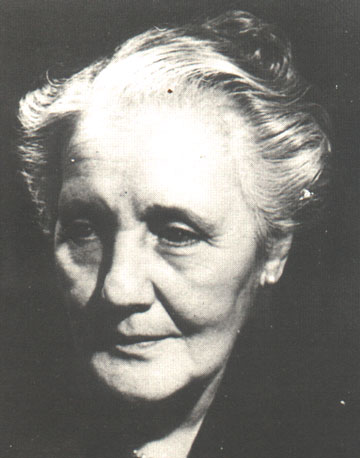 And that’s good news. For remember what Melanie Klein, for one, had to say about depression. The depressive position, she argued, was a developmental stage. It arises when the infant realises that Bad Mom and Good Mom are one and the same: when fantasies of magical redemption and fantasies of endless persecution make way for something much more painful, and much more healing: living in the real world, whose sweetness can only truly be experienced when we realise that we are alone, that we will die, that everything’s a fuckup: that I’m not magical, and neither are you, and we have to start the difficult business of being grown-ups — a thankless task, really, but can you show me an alternative?
And that’s good news. For remember what Melanie Klein, for one, had to say about depression. The depressive position, she argued, was a developmental stage. It arises when the infant realises that Bad Mom and Good Mom are one and the same: when fantasies of magical redemption and fantasies of endless persecution make way for something much more painful, and much more healing: living in the real world, whose sweetness can only truly be experienced when we realise that we are alone, that we will die, that everything’s a fuckup: that I’m not magical, and neither are you, and we have to start the difficult business of being grown-ups — a thankless task, really, but can you show me an alternative?
Robert Bly writes about this in a lovely little poem called Where we must look for help. When Noah was drifting on the flood, looking for land, neither the eagle nor the dove or the ‘split-tailed swallow’ were of much help: it was the crow that came back with mud on its feet. ‘The crow, the crow, the spider-coloured crow / the crow shall find new mud to walk upon.’ I love that line, because I love the icon of the crow, the harsh-voiced bird that, in myth, speaks unlovely truths; and that in real life survives on roadkill, wily and alert. And I think what hope there is for South Africa lies in our ability not to find a highway to the future, but to ground ourselves in that black unlovely muck. We need to find ways to enter this dark, humbling and unheroic time: a time when we can give up the magical, romantic projection onto the ‘Beloved country’ and forgive it — forgive ourselves for being what we are.
The problem with the depressive position is that it’s so damn depressing. You have to stop dreaming of the country beyond the rainbow, and start thinking about the difficult, humbling, limited interventions: the triage required of us in the here and how. But then, there is nothing that forces you to do this. Why bother? You could also keep on investing more and yet more energy in the attempt to keep the dream of Dreamland going.
This is the frightening bit. For as the smoke of the Mbeki-versus-Zuma battle clears, and as the outlines of a new terrain of struggle are slowly revealed, it is evident that there is a powerful dynamic in our country centering on the desire to stay with blindness.
This is the way of the split-tailed swallow in Bly’s poem, and at the moment, it takes the shape of two unconsciousnesses: two parallel, competing and yet deeply complementary discourses of reality-denial. The one belongs to the camp that is forming itself around the likes of Julius Malema, Judge John Hlophe, Andile Mngxitama and their entourage: a camp that projects themselves as the voice of pro-African transformation, as the enemy of white domination; but which in reality can only speak from the place of powerlessness and victimhood. The problem with this group is not only their narrow ethnocentrism, their essentialist, racist, homophobic take on what African identity must be. It is not only that this discourse seems to function mainly as a way of providing ideological cover fire for the self-aggrandisement and enrichment of a particularly narrow-minded, bigoted section of our middle class. It is that as far as I can see (and I am on the white side of the fence, mind you!) the black subjectivity being articulated here is utterly disempowered, because it seems to pivot on a refusal of the possibility of a black person being held accountable (by anyone). Thus even the awful Leonard Chuene has been told by the ANCYL that he should not apologise for his lies about Caster Semenya. Now it is plainly true that there are many white racists who see corruption or incompetence everywhere, even where it isn’t. But the tragedy for our national process is that it is now seems increasingly possible for those who really are corrupt, or delusional, or who have acted foolishly, to accuse any and all critics of racism, or of resistance to transformation. Where is the honour, where is the power, where is the leadership in that? Frank Talk – the real one, not his pale imitator – must be spinning in his desolate, almost forgotten, little-honoured grave.
The second discourse is the mirror inverse of the first, its ‘racial’ and ideological twin. It is the voice of white denial, of a narrow, ideological, illiberal liberalism that refuses to acknowledge the persistence of racialised power relations and the ideological legacy of white supremacy in post 1994 South Africa. It uses the semblance of non-racialism (an insistence on ‘colour blindness’, lip-service to meritocracy) to sabotage the equitable transformation of unequal ‘race’ relations. While never overtly racist, it pursues the agenda of protecting the vested interests of the privileged white elite created by Apartheid, by wrapping the interests of this elite in a discourse about ‘world class cities’, global ‘standards’, governance and crime.
These days, this second voice has become less strident: instead of speaking flamboyantly and accusingly from the centre it tends to mutter bitterly from the shadows. I’ve remarked on some of its manifestations before, when I’ve written on Huntley and Disgrace. But it’s not only the voice of elite alienation or white underclass complaint. You can find its views confidently articulated in the mainstream as well, most obviously in the bumptious arrogance of the Democratic Alliance which, despite its own chequered history, acts as if it has the franchise on clean government; and which, though protesting always that it is not racist, has made its political mark by playing forcefully and effectively to white and ‘coloured’ fears.
The interesting thing about these two discourses is that though they appear formally opposed, they’re really deeply co-dependent. They’re enemies, but the emnity is of that special kind: it is that comforting emnity that exists where each adversary finds in the existence of the other proof of their own deepest, fondest fears and the vindication of their stance. The comforting enemy is the person without whom you would not be yourself, to whom you only have to glance to find the validation of your fear and rage. This is perhaps most richly illustrated in the cringe-making performances of Messrs Malema and Shivambu. Shivambu, you will recall, attained national notoriety for his blustering response to those who challenged him about his allegations that DA premier Helen Zille slept with her white colleagues. Malema’s most recent escapade even more tawdry: he stands accused of beating up a neighbour who came to complain about a noisy housewarming and now denies those allegations, saying that it is all all a plot by the spies of Helen Zille. This is so silly that I do not know whether to laugh or cry; our dear GodZille is famous for not knowing how to pick her fights, but the idea of she and her cabinet of aged pale males plotting deep into the night to trip up Julius is worthy of a second-rate Hayibo story, not of serious political discourse.
But of course the compliment’s returned. Where would the DA and its ilk be without the Africanist axis? Chris Roper has publicly declared his love-hate affair with Malema , but he’s not the only one. Just as Hlophe casts himself as the agent of African transformation without actually lifting a finger to change anything material in the judiciary, white DA denialism is content to look at Hlophe and their crowd and merely find in their existence confirmation that at root, this is a continent of Idi Amins. Or more properly, this is a continent in which any African politican has got to be either a Nelson Mandela (magically statesmanlike, laundered of all white fears, ‘transcending’ their local roots) or one of a set of interchangeable, indistinguishable goons. They are not able to engage with the very real difficulties and political threats posed by the rise of xenophobic, conservative and authoritarian African essentialism, because firstly they cannot acknowledge the need for social transformation which that essentialism attempts to appropriate for its own ends, and secondly they cannot see African politics other than through their colonial-racial lenses. Through this lens, African demands for change are not responses to real problems, but the expression of an essential corruption and a primal irrationality. This evident, for example, in the media-pillorying of Malema’s school achievement. (Personally I must say that I have no problem with his 20% for woodwork, if that was ever his grade: I must confess that I did not do much better in that messy, unforgiving discipline ). More subtly, it is also evident in the way white attitudes to Zuma have flip-flopped in the past year. Present-day white relief at the fact that he seems to be a pretty competent president is a direct correlate of the way he was turned into a black bogeyman in the days running up to Polokwane.
It seems to me this kind of thing can run and run. On the one side, the smug and dull refusal to recognise the reality of entrenched racial inequalities and colonial mentality; on the other an increasingly shrill Afrocentrism that calls for a ‘debate on race’ while trying to simplify and flatten all discourse on racial problems. Everything done by the one side will justify the excesses of the other. No doubt at a certain level this will be gratifying to those involved. But what is lost is the opportunity for a real and sensible debate on what can be done to address Apartheid’s legacy.

That is why I think it is necessary to say, with as much gentleness as possible: a pox on both your houses. That is why I agree with Zackie Achmat’s refusal to give politicsweb the right to publish his criticisms of John Hlophe. Charting a genuinely anti-racist politics depends, I think, on the ability to wrest the debate away from these mutually constituted, co-dependent, ideologically narrow, blinded camps. Creating a democratic South Africa, where we can encounter one another in new ways, less shaped by predetermined paths mapped out for us by Apartheid society, requires that we map out a third terrain, beyond these two mirroring unconsciousnesses.
To live on this terrain is, as I’ve said, to some extent a saddening business. It requires an honest tally of the losses and the recognition of irreversible damage. It means foregoing the illusory safety brought by high walls and gated suburbs, and entering into a real relation with our fellow citizens. It means letting go of many heroic dreams. Instead of trying to make an entirely new South Africa, unstained by its past, I fear that we may be reduced to trying to make the present one more livable, more merciful, more various, more kind.
But that’s not a bad thing to do. It does not require the abandonment of a radical politics; in fact I think it requires its enlargement. I think it requires the addition, alongside the awareness of large scale social injustice, a more fine-grained, interpersonal and existentialist concern. A door, one of Le Guin’s characters says in one of her short stories, is opened by a very small thing — a key. Liberation is not liberation if it has not rooted itself in our fragile bodies, if we cannot live it in the freedom and authenticity of our everyday encounters.
I would like to try to abjure the rough power of the simplistic splitting that turns our multifarious country into ‘two nations.’ I would like to learn to live without the comfort of enemies. Not in the promised land, but in the gefokte land. I think we will find that there is much to love there.
lost in africa: disgrace, whiteness and the fear of desire
OK, let me start by saying straight up: I did not like this film. Disgrace left a bad taste in my mouth which I’m still trying to spit out. Which gives me pause. I have my doubts about reviews that are all about tearing something down. Disparagement’s so easy. Just the other day I had occasion to remember Toni Morrison, at the beginning of her brilliant essay on whiteness in American literature, Playing in the Dark: my project, she says, arises from delight, not disappointment. That, I think, is the proper attitude of the critic: to take seriously the artifact as it is given into her hands, and ask, really ask: beautiful thing: how are you made?
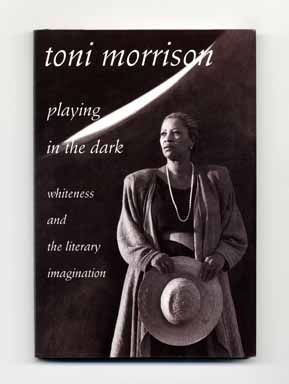 So let me also say, right at the start, this one is exquisitely made. It is a work of art. John Malkovich’s performance is as finely poised and savage as anything he has ever done. The score is ravishing. The intertwining themes that animate the book are brilliantly rendered. It is beautifully shot; everything about it is meticulously made. And therein lies the rub. For all this artistry works to deliver an unpleasant, I think poisonous payload; the melody is all the more false for the very care and deliberateness with which every note is played.
So let me also say, right at the start, this one is exquisitely made. It is a work of art. John Malkovich’s performance is as finely poised and savage as anything he has ever done. The score is ravishing. The intertwining themes that animate the book are brilliantly rendered. It is beautifully shot; everything about it is meticulously made. And therein lies the rub. For all this artistry works to deliver an unpleasant, I think poisonous payload; the melody is all the more false for the very care and deliberateness with which every note is played.
Well. As you can see, my words don’t arise from delight. Nor do they arise from disappointment. Rather, I want try to put my finger on what is that causes the queasiness and distaste this film aroused in me. Part of the reason, quite obviously, is its barely concealed racism, the way it presents — and renders culturally respectable — a particularly hateful vision of South Africa after liberation, of its people, and of the place of whiteness within it. But the racial message is only part of a deeper, darker malaise. Something really nasty’s wrong here. A life-denying, fastidious, disconnected, self-pitying narcissism permeates this film. Permeates it, I say, because I do not think it is being named or shown. Rather, I think we’re in the presence of unconsciousness: the film asks us to be complicit or identify with a tawdriness that it participates in and honours, but which it does not understand.
Let me start with the aspect of the film that is most compelling, and that stays longest in my memory: its artful, deliberate, but ultimately failed engagement with the surface texture of present day South African life. It’s interesting to compare this film with District 9. D9 is profanely non-realist (a spaceship, looming above Johannesburg? A squatter camp, crawling with eight-foot, insect-legged aliens?) – and yet achieves a gritty, giddy verisimilitude. Disgrace is elaborately, self-consciously exact, littering the screen with hundreds of tiny details carefully got just right: the dinnertime conversation at Harbour House restaurant ( I see David Lurie got a table by the scenic window, which I never achieve); the white enamel bread tin on Lucy’s kitchen countertop; the dowdy straw-hatted white women in the farmers’ market in Grahamstown; the careful, casual elegance of David and Lucy’s clothes, sourced from just the right shops in Kalk Bay and Constantia Village; the mediocre beige cloth hangings in Mr Isaacs’s George home. All these things are precisely, obsessively, tastefully just right. But all they achieve is to make the missteps that much more glaring.
The most obvious example of this is of course the film’s bizarre transposition of Grahamstown into what seems to be the Cedarberg. There seems to be no coherent reason for this disorienting move. (Steve Jacobs’s stated reason is that the Eastern Cape is not picturesque enough, which frankly makes me doubt his sanity). No doubt an American or British audiences will be none the wiser. But the Eastern Cape is South Africa’s Sertão, its Red River Valley, its remote and distant moral centre. All the stories of what happens there are indissolubly entangled with the outlines of its densely populated, desperately beautiful bare eroded hills. Seeing Disgrace played out in the prettily scenic, pastel-toned hillsides of the Western Cape is a bit like seeing West Side story transposed into the Alps, or John Wayne galloping around on a Shetland pony.
A subtler example of this same strange dislocation is the curious absence from the film of today’s post-industrial technological culture. As best as I can recall, there is with one exception, not a single mobile phone in the entire movie. For anyone who has hung around in the rural Eastern Cape, where chinese traders hawk consumer electronics on the pavement of every rural dorpie, and where every livelihood depends on something that is happening a thousand kilometres away, this is just baffling. (And it can’t be a matter of historical faithfulness to the mid-nineties, for the film quite clearly happens after 2005, if the cars are any indication.) It’s rather as if everyone has been transported bodily into another era, a South Africa untouched by the profane, demotic commercialism of present day consumer culture. The same time-warp is evident in the depiction of the party where Lucy’s tenant/landlord Petrus celebrates his land transfer. Who are these strange black people, dressed in such awkward, dated ways? And what is this music they are playing? Where are the gritty, nasty township beats? Where’s Chiskop, Bongo Maffin, or (if you really want to be cliched), Mandoza? Or, if the point is that Petrus is old-fashioned, at least Simphiwe Dana? Instead, we have this strange accordion-playing trio, straight out of some imaginary rendition of the fifties. One is left peering at the screen in irritated consternation, trying to figure out just where all this is supposed to be happening. What country is being imagined here?
The answer, I think is clear. It is, guess what, “the beloved country.” It is South Africa as scenery. It is that well known, often rendered, but entirely imaginary landscape of the high-culture, patrician, white English South African literary imagination. It is Smutsworld. It was originally rendered freshly by Bosman, Marais and Paton (and, yes, consciously and ironically by Coetzee), but by now it has become a literary trope, a cliche. It is the very opposite of District 9: it is Stephen Watson country; the landscape we need to imagine ourselves in when we white South Africans need to experience ourselves as poetical, literary, tragic and refined: a landscape that is always imagined as empty, even when it is populated.
Where this falseness finally becomes ugly is in the depiction of the relationship between Lurie and his daughter on the one hand, and the baleful, enigmatic figure of Lucy’s black tenant Petrus. At first glance the casting of Eric Ebouaney in this role is perplexing: the film clearly spent a fortune on accent coaches, but try as he might, Eric just sounds like a foreigner. Could they not have cast, even, say, John Kani? But Kani, you see, would have imbued that role with humanity and warmth. You would have liked Petrus, had Kani played the man. And what Ebouaney gets exactly right is the cold, robotic indifference required of him in this role. It is an astonishing performance, because what it portrays is so horrible and so false. Anyone who knows anything about patron-client relations among white and black in the rural Eastern Cape countryside would be able to tell you: Petrus’s matter-of-fact callousness at the rape of his landlady and neighbour would be, in terms of the codes of rural conduct, simply unthinkable. And I am not denying that murder and rape do happen. But a person of his age and status and situation who behaves in this way would be thought a psychopath, by white and black alike.
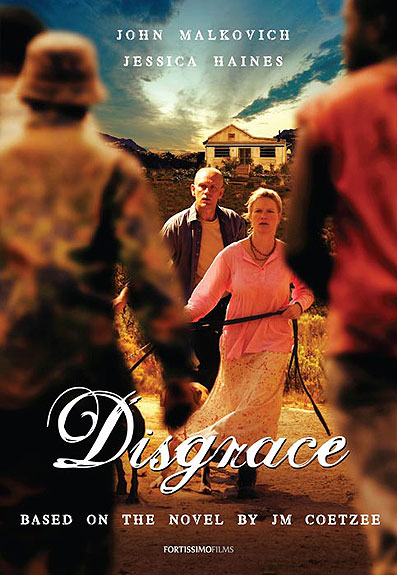 But you see, reality is not what matters here. For Petrus is not a real person; he is a figment of the imagination. He is a projection of a very particular kind. For what the movie does is to present to us — and lend support to — a very specific, and enormously prevalent, racialized fantasy about what South Africa is today. That fantasy is, you might say, the world according to Brandon Huntley: liberated South Africa as a hell for white victims. In this aspect, the movie is unremarkable. The story it repeats is told again and again everywhere around us – from the embittered complaining you might hear on Radio Pretoria to the angry excesses of sites like zasucks.com.
But you see, reality is not what matters here. For Petrus is not a real person; he is a figment of the imagination. He is a projection of a very particular kind. For what the movie does is to present to us — and lend support to — a very specific, and enormously prevalent, racialized fantasy about what South Africa is today. That fantasy is, you might say, the world according to Brandon Huntley: liberated South Africa as a hell for white victims. In this aspect, the movie is unremarkable. The story it repeats is told again and again everywhere around us – from the embittered complaining you might hear on Radio Pretoria to the angry excesses of sites like zasucks.com.
Its key propositions are familiar: to be white in South Africa, it says, is to be simultaneously the sole custodian of civilisation and morality and to be stained, if only through association, with moral responsibility for the brutality of Apartheid repression and unearned privilege. This also means that to be white is to be the object of black rage. The form that this rage will take is rape, theft, violent crime; uncontained rapaciousness, savagery, uncouth bestial cruelty. Neither the state nor law-abiding black people can be counted on to offer meaningful solidarity or reliable protection. White guilt and global hypocrisy mean that the world will look away; so this violation will be underpinned by isolation and marginality. To be white in South Africa is therefore to face a choice between, on the one hand, flight and embittered nostalgia for the sundrenched homeland and, on the other, abject consent to violation. Such consent will not bring redemption. Instead it will bring an equally embittered isolation, far from the safety and security of the normal world where other whites — whites just like us — live lives cosseted in ignorance and moral certainty.
And so on.
All this is fairly evident, and should be obvious, I think, to anyone who has eyes to see. But in a way it’s incedental. It is epiphenomenal. For what what makes the whole film hang together, its moral core, is not simply this frightened, isolating view. It seems to me that the film’s endorsement of the racist fantasy is linked to a deeper, more elusive problem, which is its underlying moral and existential stance – its denial of the possibility of relationship as such; its fear of life; its murderous attitude towards desire.
 Perhaps one way to frame this problem is to note, that brutal and inhuman as its portrayal of black South Africans is, that is as nothing to how the movie portrays the whites. Here, Malkovich and Haines are brilliant in their roles. They perfectly convey the maladies the characters embody. Two sorrier specimens of humanity cannot be easily imagined. Malkovich’s feral, distant, self-hating Lurie is precisely acted: a man who professes himself to be a servant of Eros, but whose predatory seduction of his student borders on rape; a man who claims to follow desire, but who is clearly unable to enter into the vulnerability and openness that desire brings. He quotes Blake on how it is better to murder an infant in its cradle than to nurse unacted desire, but in reality he cannot allow desire to live. Here, the dogs lay a central role in the film. What can a dog do but enter trustingly, vulnerably, innocently into life and connection? Lurie cannot suffer that to live, because for him, to live thus is to suffer. The only thing, the kindest thing you can do to desire, is to snuff it out, to kill it on the vet’s steel table. As for Lucy, she’s even more a caricature of of hysterical disconnection from the instinctual self. She’s nothing but a victim; she sets up her own attack with neurotic, self-destructive precision.
Perhaps one way to frame this problem is to note, that brutal and inhuman as its portrayal of black South Africans is, that is as nothing to how the movie portrays the whites. Here, Malkovich and Haines are brilliant in their roles. They perfectly convey the maladies the characters embody. Two sorrier specimens of humanity cannot be easily imagined. Malkovich’s feral, distant, self-hating Lurie is precisely acted: a man who professes himself to be a servant of Eros, but whose predatory seduction of his student borders on rape; a man who claims to follow desire, but who is clearly unable to enter into the vulnerability and openness that desire brings. He quotes Blake on how it is better to murder an infant in its cradle than to nurse unacted desire, but in reality he cannot allow desire to live. Here, the dogs lay a central role in the film. What can a dog do but enter trustingly, vulnerably, innocently into life and connection? Lurie cannot suffer that to live, because for him, to live thus is to suffer. The only thing, the kindest thing you can do to desire, is to snuff it out, to kill it on the vet’s steel table. As for Lucy, she’s even more a caricature of of hysterical disconnection from the instinctual self. She’s nothing but a victim; she sets up her own attack with neurotic, self-destructive precision.
The movie’s world, then, is a world in which connection and relationship is impossible. The alternatives are simple. On the one side is the world of whiteness, which is a world of solitude, of neurotic disconnection from instinct and desire. On the other side, a bestial blackness — vigorous but incapable of kindness, insensible to suffering, coldly materialistic, harshly physical. They are, of course, two sides of the same coin; two aspects of the same fantasy.
Much can be written here, of course, about the movie’s relationship to the book. As several critics have pointed out, the novel gives you the added complexity of the character’s interior dialogue. Events and acts depicted on the screen can, in the novel, be rendered with additional layers of irony and self consciousness. This is particularly true of Coetzee, who always writes to distance the reader from the concerns of the protagonist. Coetzee’s writing at times is distinguished by an implacable, basilisk gaze; it is as if South Africa has given the world its only Cthuhlu novelist, regarding the writhings of its human subjects with an icy, million-year-old gaze, as if they are maggots under a microscope. One might with reason wonder why that kind of thing is as widely admired as it is – the guy’s being pipped for his third Booker, if I hear aright. But that’s not the point here. Let us simply note that it could be that Coetzee the novelist is dissecting all this disfunction, splaying it pitilessly on the operating table for us to see and understand.
It could be. I do not know. But that most certainly is not what is happening in the film. The movie treats this life-denying, fearful, disconnected stance as if it is the only way to be. No alternatives are offered, no different perspective is explored. This self-pitying vision, the film suggests, is how things are. You can stay in the white citadel, where you may still attempt to ravish, coldly and without pleasure, the reluctant daughters of the former servant class. They will coolly submit, but they will have their revenge. Or you can give up the trappings of privilege. You can suffer your daughter to be raped, and you can sit on your back stoep, picking out desultory phrases on your mandolin, while the savage children of the new nation leer at you over the barbed wire fence.
Why?
Because you would die rather than enter into relationship. You would die rather than take that risk.
Hmmm.
You know what? I don’t buy it.
the alienation effect: further thoughts on D9.
It has been an interesting week. District 9 has continued to excite much interesting debate, and so has the damned Huntley affair. I have lately been laid low by a virus – relax, it is neither H1N1, nor something of alien provenance – just a middle-ear infection; but it gave me opportunity for many fevered dreams, in at least one of which I found myself living on a rainy pine-infested landscape, sharing a homestead with Wikus, Brandon Huntley and Caster Semenya, who for some reason appeared to be white. The pine forest referencing not so much Brandon’s (now, it seems, perhaps temporary home) but the book I am reading now, Annie Dillard’s gorgeous novel of North American colonial life, The Living. Which is another kettle of fish entirely.
For now, what want to do is to offer a few more thoughts on that fascinating movie. I have been to see it a second time; I have learned a lot from other reviews and from some thoughtful and perceptive comments on my previous post; I have been trawling the internets with delight and alarm. I’ve also had the occasion of an interesting email exchange with Barnor Hesse, one of the more penetrating observers of racism in these ‘post-racial’ times. I thought I would offer for more general discussion and tearing-apart some of what I wrote to him.
Firstly, regarding the ‘Nigerians’. I think a few things can be borne in mind. Firstly, it is undeniably true that the movie serves up a very in-your-face, stereotyped image of the African racial other, with all the signs and signifiers familiar from hundreds of years of racial stereotyping. The ‘Nigerians’, indeed, are almost surrealistically caricatured: as Belle Prannyshake pointed out in her perceptive comments in this blog and elsewhere, they are ‘cannibalistic, lusty, hot:’ one of them walks around with a python around his neck; I swear that I saw one with a hyena on a leash; and consistently the camera emphasises their brutality, their blackness, their bestiality, etc. It is, indeed, strong meat.
Secondly, it does bear remembering that the movie has its origins in a short film very deliberately and consciously seeking to problematize South African discourse about immigrants and specifically ‘Nigerians.’ Blomkamp’s clip ‘alive in Joburg’ is fascinating viewing; one of the best examples of the Brechtian ‘alienation effect’ (ahem!) I have seen: for the movie, Blomkamp interviewed real South Africans talking about immigrants, and juxtaposed the vox pops with footage of space aliens. The decontextualization effected by the science fiction works powerfully and subversively to highlight the dehumanizing logic of xenophobic discourse. As Belle points out, it is dangerous to get into ‘intentions’ when analysing a text, but I do think that we can at least allow them to complicate our readings.
Thirdly – and perhaps this is another place where foreigners will miss out on some subtleties – the ‘Nigerians’ in the movie are not Nigerians at all. The indigenous medical practices attributed to them are to my knowledge not at all ‘Nigerian’ in character, but much more local in nature. Quite a few times, some of them seem to be speaking what sounds like Swahili. I was powerfully reminded of my days of living in Muizenberg, where I would often hear complaints about the ‘drug-dealing Nigerians’ by local whites… none of whom could explain to me why most of said ‘Nigerians’ spoke French. Same in the movie. The ‘Nigerians’ are in fact named as such only by the whites in the movie. In other words, the movie is careful to give us clues that they are ‘Nigerian’ only in the way that Rwandans, Cameroonians, Senegalese, Somalis and Congolese in South Africa are ‘Nigerian’ – viz. only within a very particularly racist gaze. So it is clear that Blomkamp and co are doing something rather complex – not so much offering a racist caricature, as caricaturing racist stereotypes themselves – which is a different thing entirely.
Fourthly, on seeing it a second time, I had the nagging but distinct sense that although the ‘Nigerians’ are portrayed as brutal, bestial, etc etc, there is also a distinct sense in which they are admirable. They are the only humans in the film who do not react to the aliens with squeamishness. They are uncannily like Wikus in one sense (they want to become the Alien); but they are also like the MNU (they want the weaponry). They are at home in the landscape that most humans regard with distaste, and which the MNU can only occupy and traverse with weapons and armoured vehicles. Most importantly, there is an honesty about ‘Obesandjo’s’ lust for power that contrasts very favourably with the MNU’s heartless machinations.
This is linked to a bigger set of underlying issues, which is that I think the Nigerians are deeply necessary to the ‘representative economy’ of the movie, in that they represent a very particular set of ideas and narrative possibilities. In a way, Wikus, the MNU and the ‘Nigerians’ all represent very distinctly different ways of relating to alienness.
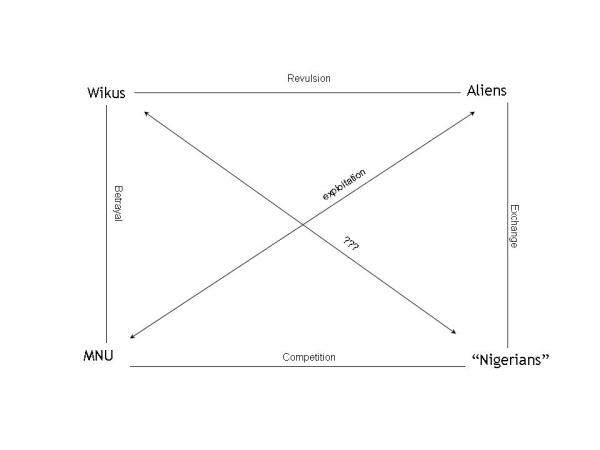 This diagram may look familiar to some of you: it looks a bit like a Greimasian semeiotic square, which is a way of exploring conceptual opposition and contrast in a text or representation. In a Greimasian thinking, the opposition between the concepts ‘human’ and ‘alien’ is one that involves not two terms, but at least four: for example, not only human and alien but also not-human, not-alien.
This diagram may look familiar to some of you: it looks a bit like a Greimasian semeiotic square, which is a way of exploring conceptual opposition and contrast in a text or representation. In a Greimasian thinking, the opposition between the concepts ‘human’ and ‘alien’ is one that involves not two terms, but at least four: for example, not only human and alien but also not-human, not-alien.
This helps us understand the nuances of this opposition much more clearly. In the above diagram, the horizontal axis, left to right, relates to the ‘alien’/ not ‘alien’ distinction. On the left are Wikus and the MNU – the side of the ‘us’ in racist discourse, defined in opposition to ‘alienness’, and whatever it is that exists in the expelled, cordoned off terrain of ‘District 9’. On the right is the ‘other’, that-which-needs-to-be-expelled (and expelled ever further; as we learn right at the start of the movie, District 9 is not far enough: the nightmare logic of racism is that District 9 turns out to be too close; it needs to be cleaned up and replaced by District 10). And as is very clear from the movie, this is a terrain that belongs as much to the ‘prawns’ as to the ‘Nigerians’.
But that is not the only axis of differentiation. The vertical axis, the axis of up-and-down, differentiates the protagonists according to the extent to which they are ‘human’ – capable of fellow-feeling, kinship loyalty, and vulnerability. This is what separates Wikus and ‘Christopher Johnson’ from the MNU and the ‘Nigerians’: while the MNU and the Nigerians are ‘inhuman’ and heartless, interested only in power and exploitation, the movie links Wikus and the ‘Prawns’ with themes of sentiment and affection (thus we have Wikus’s love for Tanya, and we also have the classic, almost corny Bill Cosby- style father-son bond between ‘Christopher Johnson’ and ‘his’ alien ‘son’). Most importantly, Wikus and the Aliens have this in common: they want to get ‘fixed’. They want to go home.
So the ‘Nigerians’ are not a simple afterthought or a plot mechanism. They embody the possibility of gutsy human survival and adaptation within the badlands of ‘district 9’. They are clearly preferable to MNU: much less calculating, and also much cooler in a kind of post-apocalyptic, Mad-Max way. There is much, one might think, that Wikus might be able to learn from them, and they from him. But the film maintains the separation between Wikus and them: his heart belongs with his ‘angel’ in the white suburbs; even though he has become an alien by the end of the movie, he cannot ‘go over’ to ‘that other side.’ While Wikus might go home, and while the Aliens might fly away to their distant planet, the Nigerians are the true aliens of the film, comfortabe denizens of the crime and war zone.
Which brings me to my fifth point: I do think that the representation of the ‘Nigerians’ is the one place in the film where the movie falters in its ability to unpick the workings of racist ideology. Because, for all of these interesting complexities, the reality is that the movie does not obviously withdraw or complicate its apparent endorsement of the African stereotypes. There are ironies and complexities — but they are evident only to a fairly sensitive and conscious viewer. In fact, the film actively pushes these complexities in side. The crucial flaw, in fact, lies lies precisely in this: it relies for its narrative drive, for its satisfaction of the ‘adventure’, on the antagonism against (and the extermination of) the ‘Nigerians’. So even though the real villains are all white, and even though the movie subtly mocks xenophobic discourse, many audiences will no doubt identify with this ‘othering’, and will cheer when Wikus’s alien exoskeleton kills them all so picturesquely.
So, as I said, a troubling film. But, I think, important and worth taking seriously for all that. In the end, despite these flaws, the movie works powerfully to raise disconcerting questions about identity and ‘othering’ both inside and outside South Africa. As a South African today, where ‘aliens’ are still routinely deported, I think the film is playing an enormously important role in asking questions and encouraging debate about the way in which xenophobic logic and modernity still interpenetrate in our government today. In those terms, it has been massively successful, at least here. And it has relevance beyond South Africa. As many commentators have pointed out, the alliance of brutal violence and bureaurcratic form that it so carefully depicts is found in Guantanamo Bay as much as it is in Gauteng. MNU’s DNA is that of Blackwater and Halliburton as much as it is that of Armscor and Denel.
And somehow – and this, I think is the genius of the film – it has done so in a way that almost perfectly marries form and content. Why does the film ‘need’ to be a science fiction film in order to make its points about South Africa… and why does it take a South African setting to make a science fiction film which feels so grittily real? The answer is, I think, twofold. Firstly, that the best science fiction has always been ‘news from the present’, focusing on what we are through pictures of what we are becoming. And secondly, I think one can say that postcoloniality is futurity. If the future is now, what country better encapsulates that future than South Africa, with its confluence of violence, race, inequality,technology, regulation, despair and hope?

